According to this article from the Smithsonian, what constitutes traditional Armenian cuisine is a frequent topic of discussion among Armenians. The definition of Armenian food seems to change depending on who you ask and where they’re from. According to the author, much of the confusion stems from Armenia’s “complicated history of wars, genocide, kingdoms, and conquerors”.
Armenian food traditions were formed over thousands of years in the Armenian Highlands, a fertile region well-suited to growing wheat, lentils, apricots, figs, and pomegranate. However, its location made it a prime place for conflict between warring empires which in turn made Armenian food culture subject to constant change.
Waves of immigration further altered the face of Armenian cuisine to the point that Armenian dishes consumed in the Caucasus are often vastly different from the Armenian foods familiar to the diaspora. The perfect example is choreg, an Armenian Easter bread made with ground sour cherry seeds. It’s one of the most beloved dishes in the diaspora but virtually unknown in Armenia.
My better half spent a good portion of her life in Los Angeles, home to the largest Armenian-American population in the US. People who live in places where Armenian food is readily available may think they’re familiar with the food in Armenia, but as these next thirty dishes will show you, that may not necessarily be the case.
ARMENIAN FOOD QUICK LINKS
If you’re visiting Armenia and want to really dive into the cuisine, then you may be interested in joining a food tour.
TOURS & OTHER SERVICES
- Food Tours: Food and Wine/Drinking Tours in Armenia
- eSIM: Armenia eSIM
Save This on Pinterest!
No time to read this Armenian food guide now? Click on the save button and pin it for later!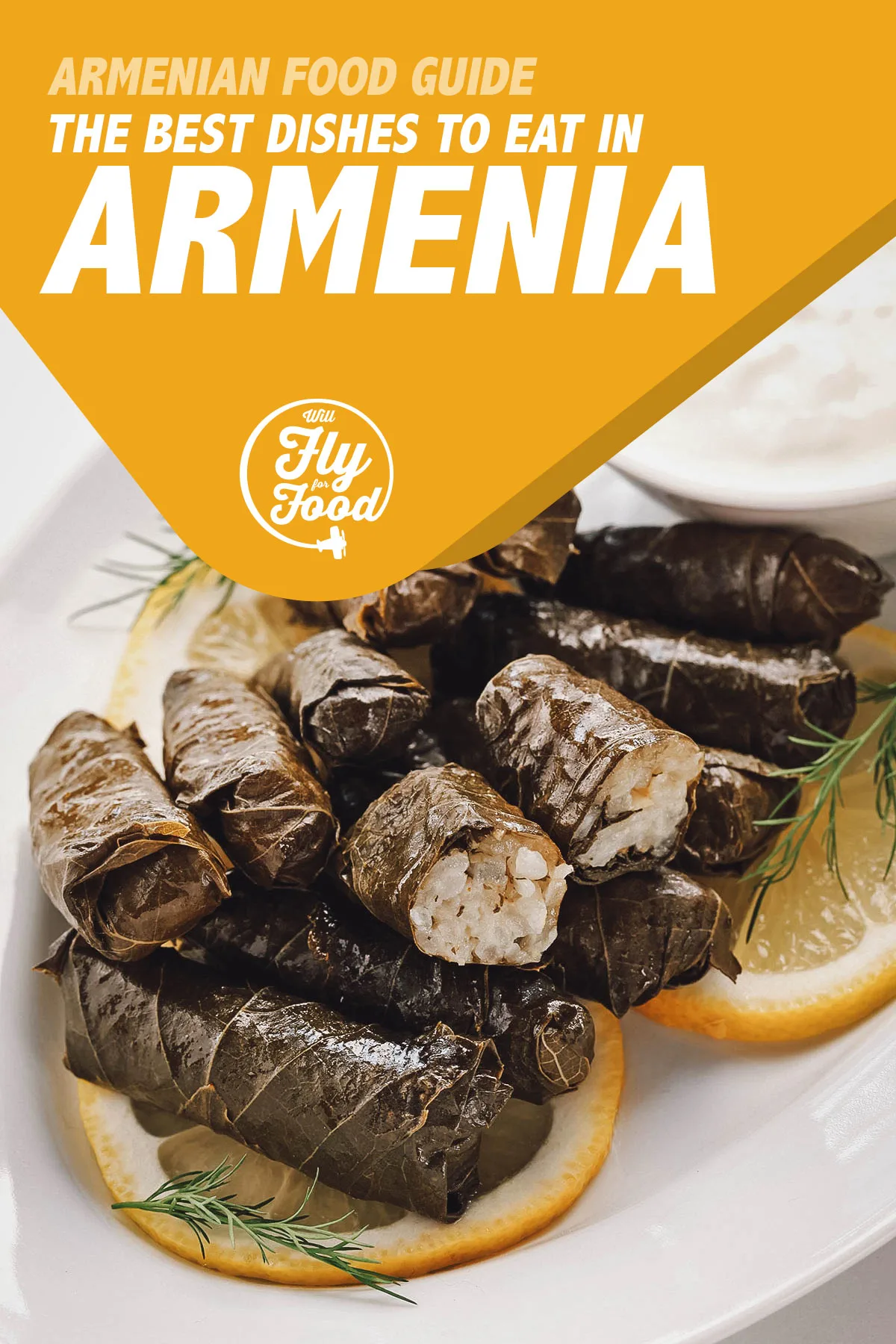
Photo by asimojet
WHAT IS TRADITIONAL ARMENIAN FOOD?
Armenian food is a reflection of the country’s history and geography. Lamb, eggplant, yogurt, and lavash are staples in the Armenian diet while bulgur is traditionally preferred over rice or maize. Often, the flavor of Armenian food is dictated by the freshness and quality of its ingredients rather than from a heavy-handed use of spices.
Fresh and dry herbs are used extensively in Armenian cuisine. Wheat is the primary grain and exists in many forms like bulgur, whole wheat, semolina, and shelled wheat. Nuts and legumes are used liberally while a variety of fresh and dried fruits like apricots, pomegranate, sour cherries, and sumac berries are used as main ingredients and souring agents in many Armenian dishes.
Because of their geography and shared histories, many Armenian dishes can also be found in similar forms in the cuisines of its neighbors like Georgia, Turkey, Azerbaijan, Iran, and the North Caucasus.
THE BEST FOOD IN ARMENIA
A list of 30 dishes can be a mouthful so this Armenian food guide has been organized by category to make it easier to digest. Click on a link to jump to any section of the guide.
STARTERS / SALADS / SOUPS
1. Dolma
Dolma (or tolma) is one of the most popular traditional foods in Armenia. It’s widely considered to be an Armenian national dish and is equally popular in the cuisines of many countries in the Balkans, the South Caucasus, Central Asia, and the Levant.
Dolma comes in many forms and goes by different names depending on where it’s from, but it’s typically made with a mixture of ground meat (usually beef or lamb), rice, herbs, and spices wrapped in vine or cabbage leaves, or stuffed in vegetables. They can be served hot or cold, with or without meat, and often with a creamy yogurt (matsun) and garlic sauce with fresh Armenian lavash or pita bread on the side.
It’s important to note that wrapped versions of dolma can also be referred to as sarma. The terminology can be confusing but a distinction is made between dolma dishes that are wrapped and dolma dishes that are stuffed. The term sarma means “rolled” or “wrapped” while dolma means “stuffed” or “filled”. By those definitions, versions of the dish made with vine or cabbage leaves are called sarma while hollowed out and stuffed vegetables are known as dolma. This will make more sense when you see the pictures below.
Other than the vessel used, the stuffing remains the same and all versions of this beloved Armenian dish, whether wrapped or stuffed, can be collectively referred to as dolma. Pictured below is yalanchi sarma, a meatless type of sarma made with grape leaves.
RECIPE: Armenian stuffed red peppers
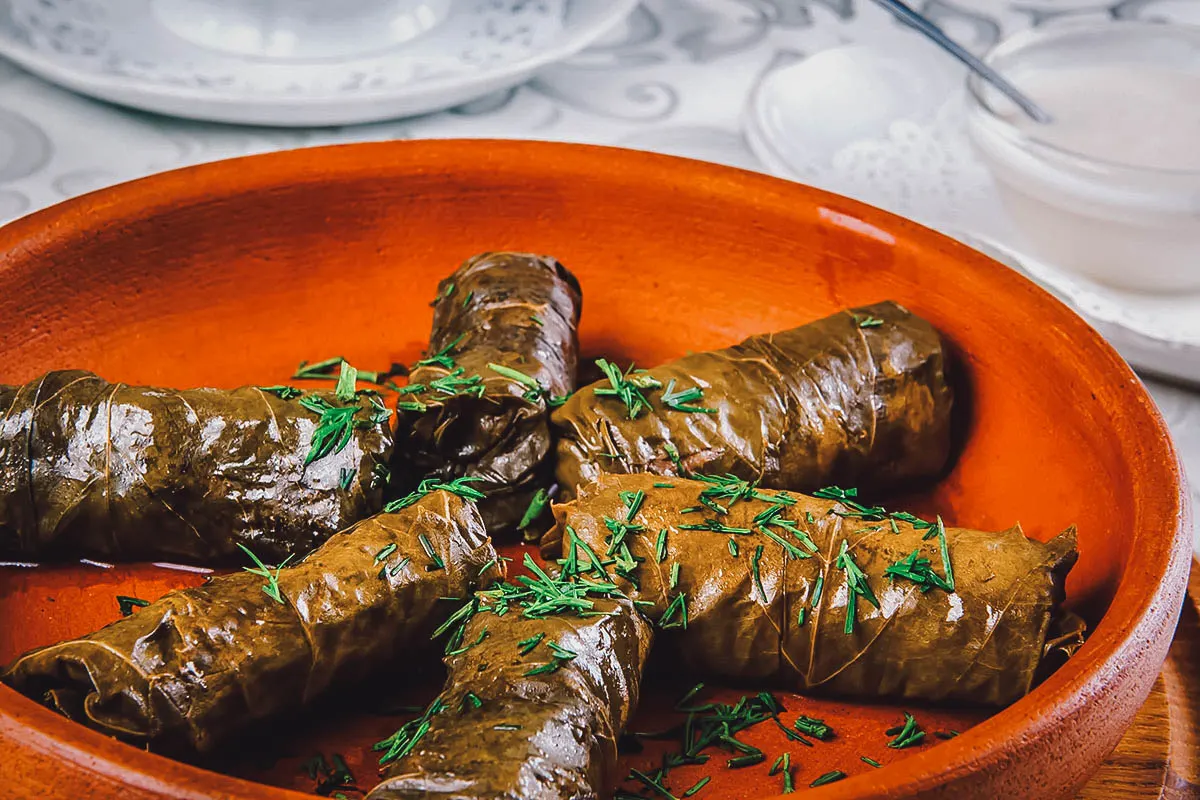
Photo by lvssvl1
Dolma can be made with different types of vegetables like bell peppers, zucchini, tomatoes, and onions. The vegetables are hollowed out before being filled with the stuffing and cooked.
So important is dolma to Armenian cuisine that a dolma festival called Uduli is held in a different part of Armenia every year. The festival showcases dozens of varieties of dolma and features a cooking competition between the country’s best cooks and chefs. They compete to see who can create the best dolma based on taste, presentation, and concept.
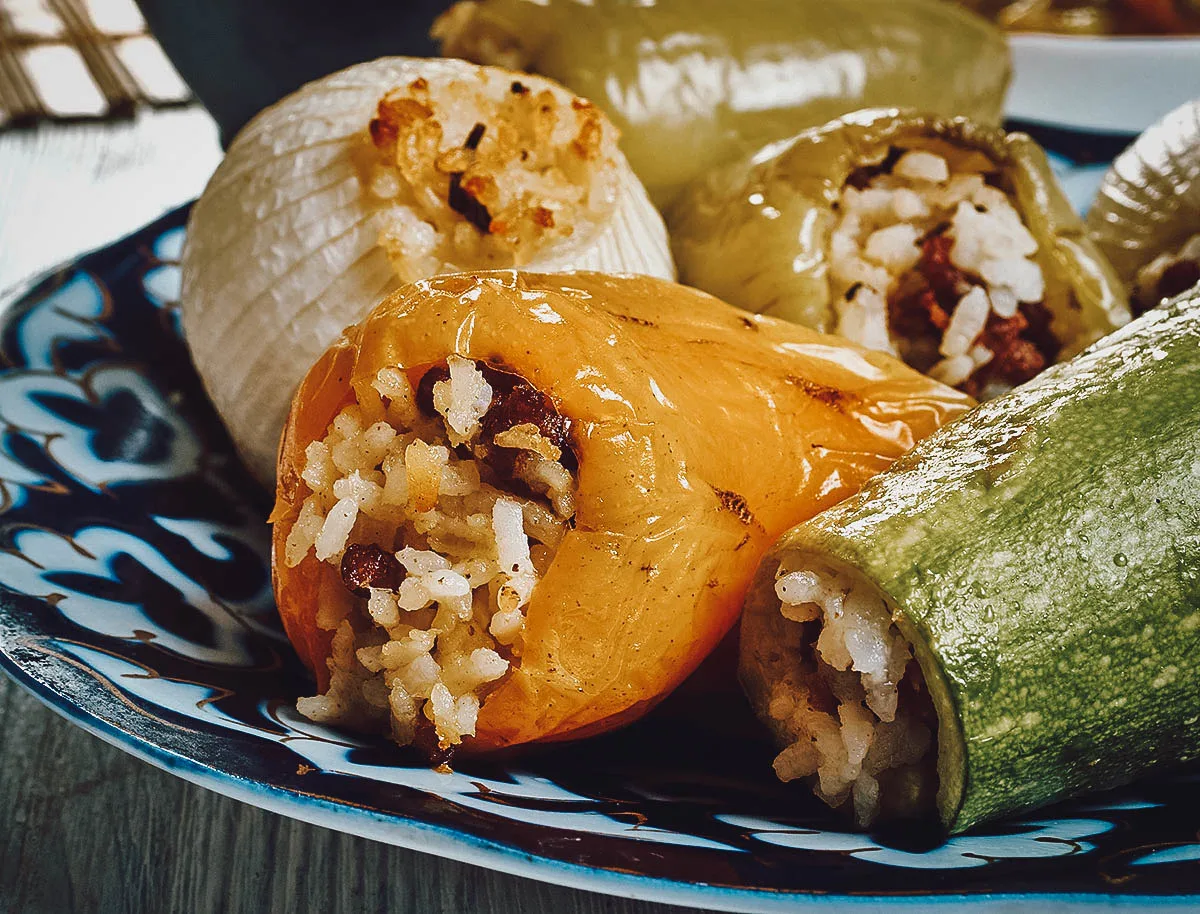
Photo by fanfon
2. Manti
Manti (or monta) refers to a type of dumpling popular throughout the South Caucasus, Central Asia, the Balkans, and beyond. They exist in many forms but Armenian manti are typically made with a spiced meat mixture, usually ground lamb or beef, wrapped in thin dough that’s either boiled or baked.
Unlike other types of manti, Armenian manti are smaller in size and always made in an open canoe shape. They’re often served with a sauce made from matsun or ttvaser (sour cream) and garlic, or in an Armenian soup called sulu manti. Manti are generally more common among western Armenians while a similar dumpling called khinkali is preferred in the east.
RECIPE: Manti
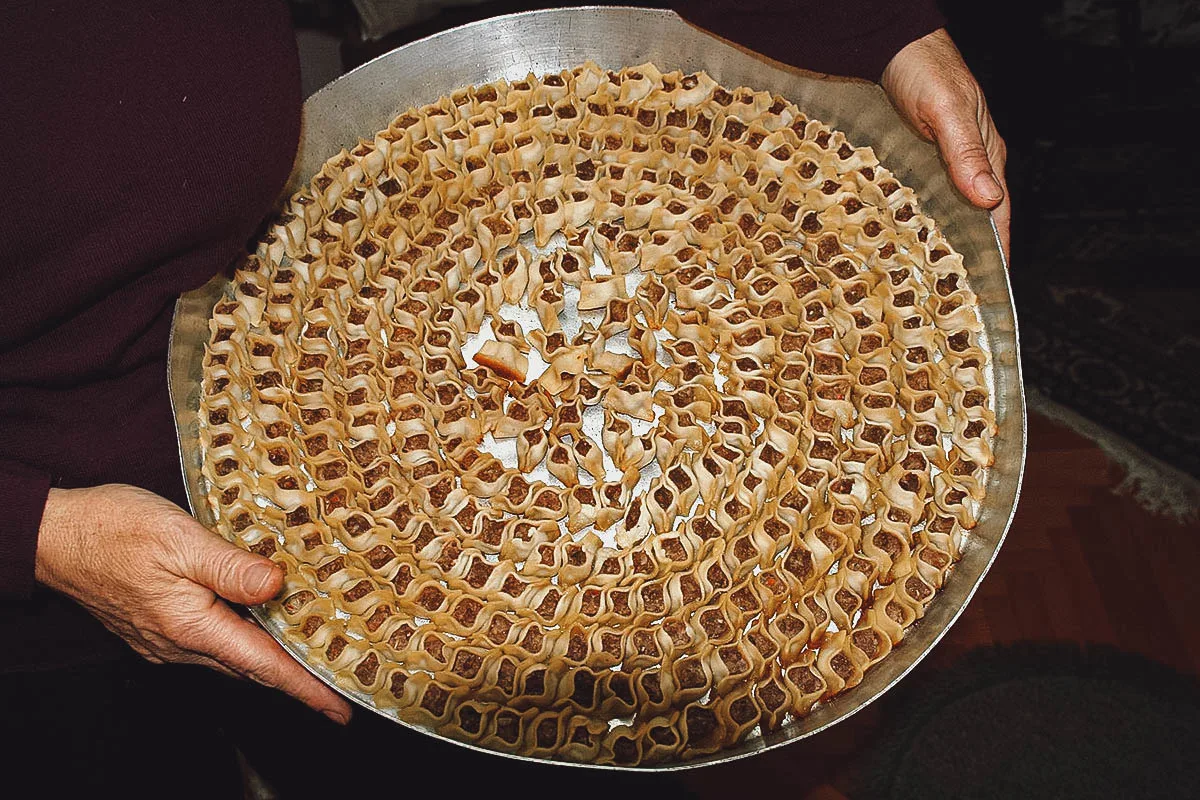
Thomas Steiner, CC BY-SA 3.0, via Wikimedia Commons / Processed in Photoshop and Lightroom
3. Eech
Eech (or itch) refers to an Armenian bulgur salad. It’s similar to Lebanese tabbouleh except in eech, the bulgur isn’t just a supporting ingredient, it’s the star of the dish.
Recipes for eech vary but it’s typically made with bulgur, tomatoes, onions, parsley, bell peppers, paprika, lemon, and olive oil. It can be served warm, chilled, or at room temperature, usually as a salad, side dish, or spread with fresh pita bread, lavash, or crackers.
Eech is also referred to as “mock kheyma” or “meatless kheyma”. It’s a common Lenten dish but it can be enjoyed at any time of the year.
RECIPE: Eech
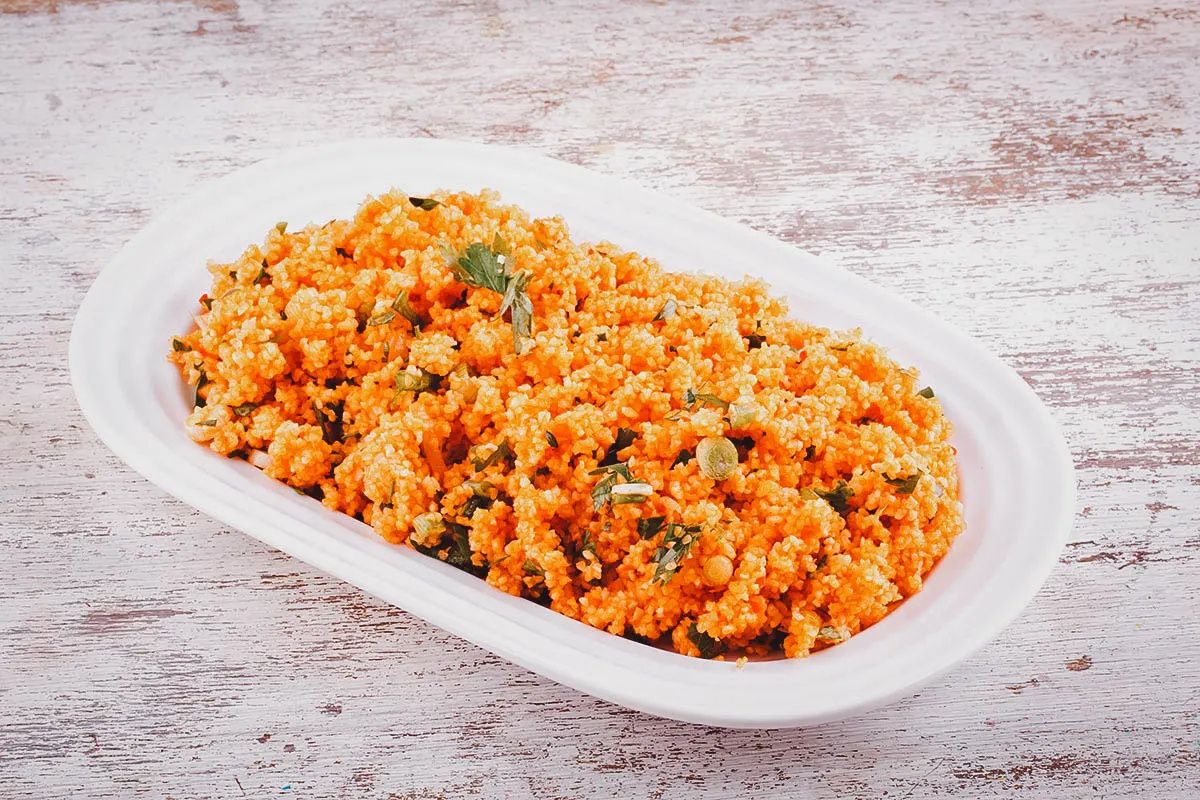
Photo by Bernashafo
4. Yershig
Yershig (or suǰux) is the Armenian version of sujuk, a dry fermented sausage popular in the Balkans, the Middle East, and Central Asia. It’s made with ground meat – usually beef or lamb – and a host of different spices and seasonings like garlic, cumin, sumac, paprika, and salt.
Yershig is known to be a fairly spicy and salty sausage with a high fat content. It’s a versatile ingredient that can be prepared in many different ways. When raw, it’s hard and stiff so it’s usually cut into slices and cooked in its own fat. It can be pan-fried with eggs and vegetables, baked into pastries, made into a filling for sandwiches, or used as an ingredient in stews.
RECIPE: Yershig
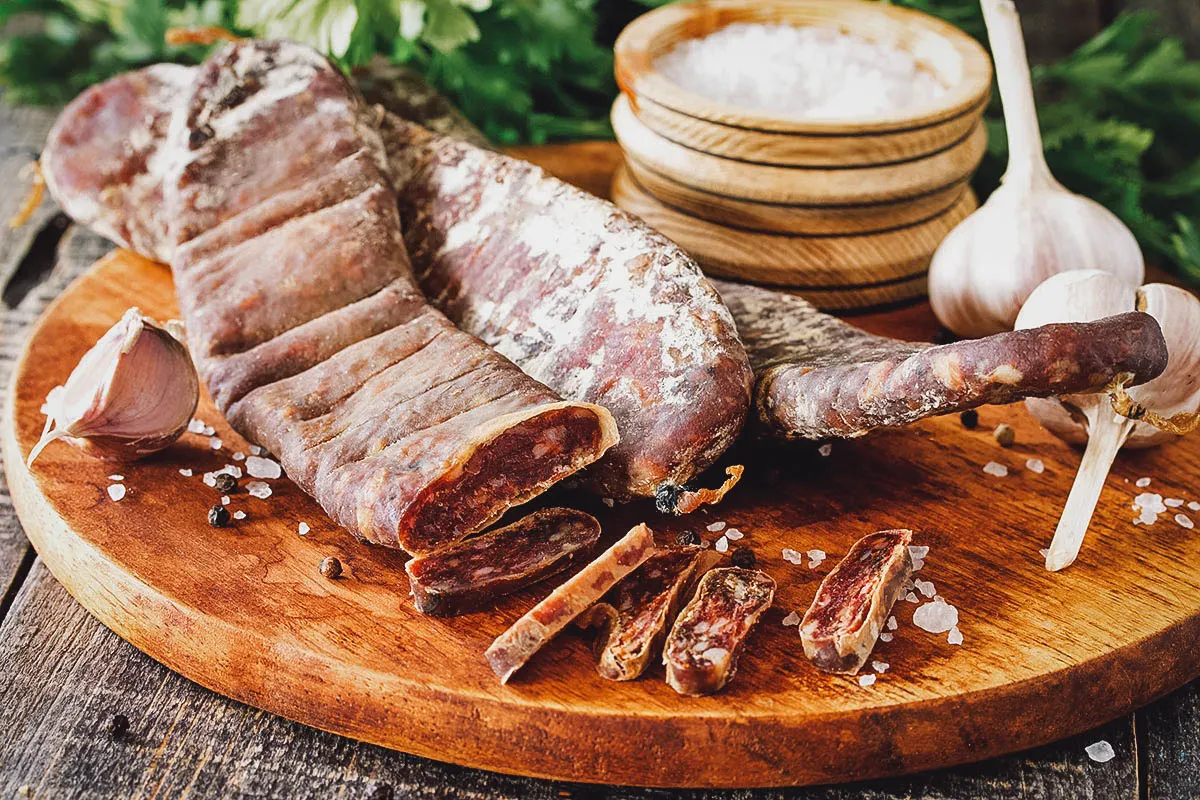
Photo by elena.hramova
5. Basturma
Basturma (or abouhkd, pastirma) is a type of highly seasoned air-dried cured beef. It’s believed to be Armenian or Turkish in origin but it’s popular in the cuisines of several other countries like Greece, Egypt, Bulgaria, and North Macedonia.
Basturma is typically made with beef or water buffalo but it can be made with other meats as well. To prepare, the meat is rinsed and salted before being dried and cold pressed for up to sixteen hours to remove moisture. It’s then dried for several days until the fat melts and forms a white layer.
The next step involves hot pressing the meat and covering it with a spice paste mixture (çemen) made from ground fenugreek seeds, chili powder, and mashed garlic. It’s then left to dry again before it’s ready to be consumed. The entire process takes about a month.
Because of the Armenian diaspora, basturma has become popular throughout the Middle East. It can be eaten in many ways – as charcuterie, cooked into omelettes, or stuffed into phyllo pastries.
RECIPE: Basturma
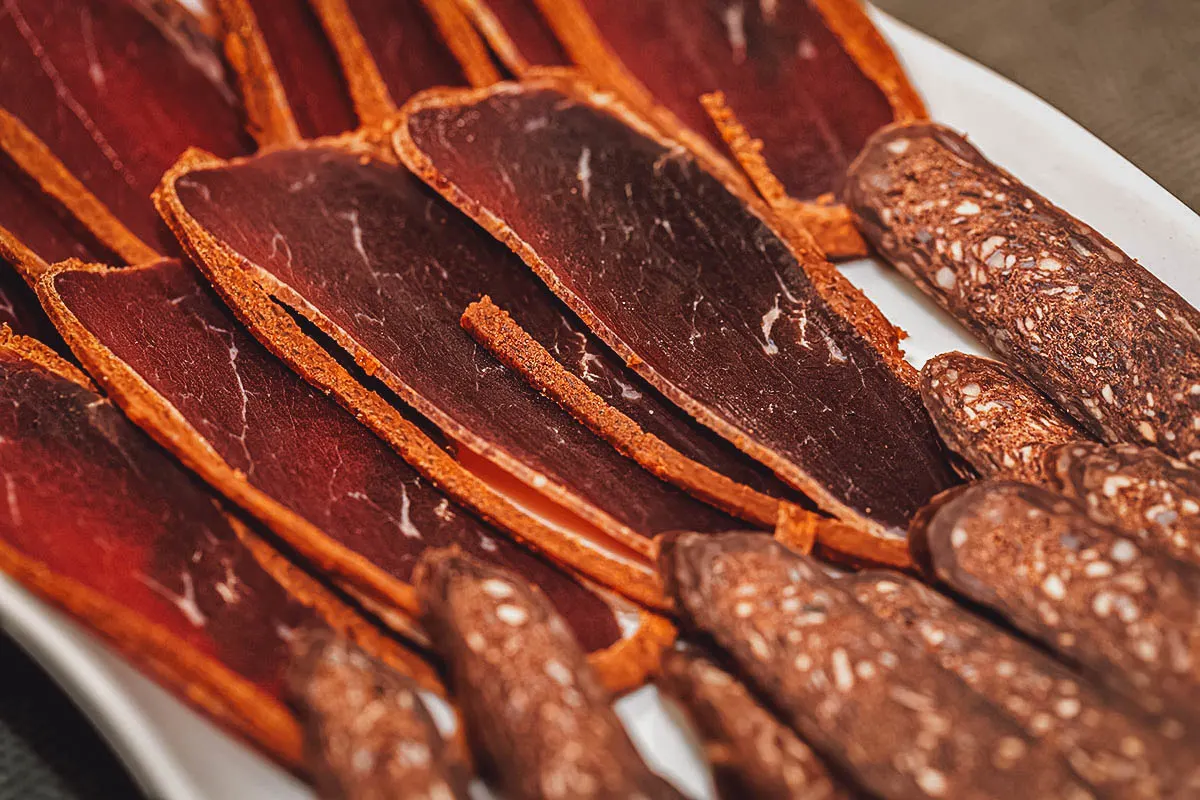
Photo by LiubovMernaya
6. Kololik
Soups and stews form an important part of the Armenian diet, especially during winter. Armenian winters are long and cold so hot soups like kololik are served almost daily in Armenian homes.
Kololik refers to a type of Armenian meatball soup. It’s a comforting and warming dish consisting of meatballs made with ground lamb, rice, onions, parsley, and seasonings. The broth is flavored with beef stock and made with rice, onions, tarragon, and potatoes. Beaten eggs can also be used to thicken the soup.
RECIPE: Kololik
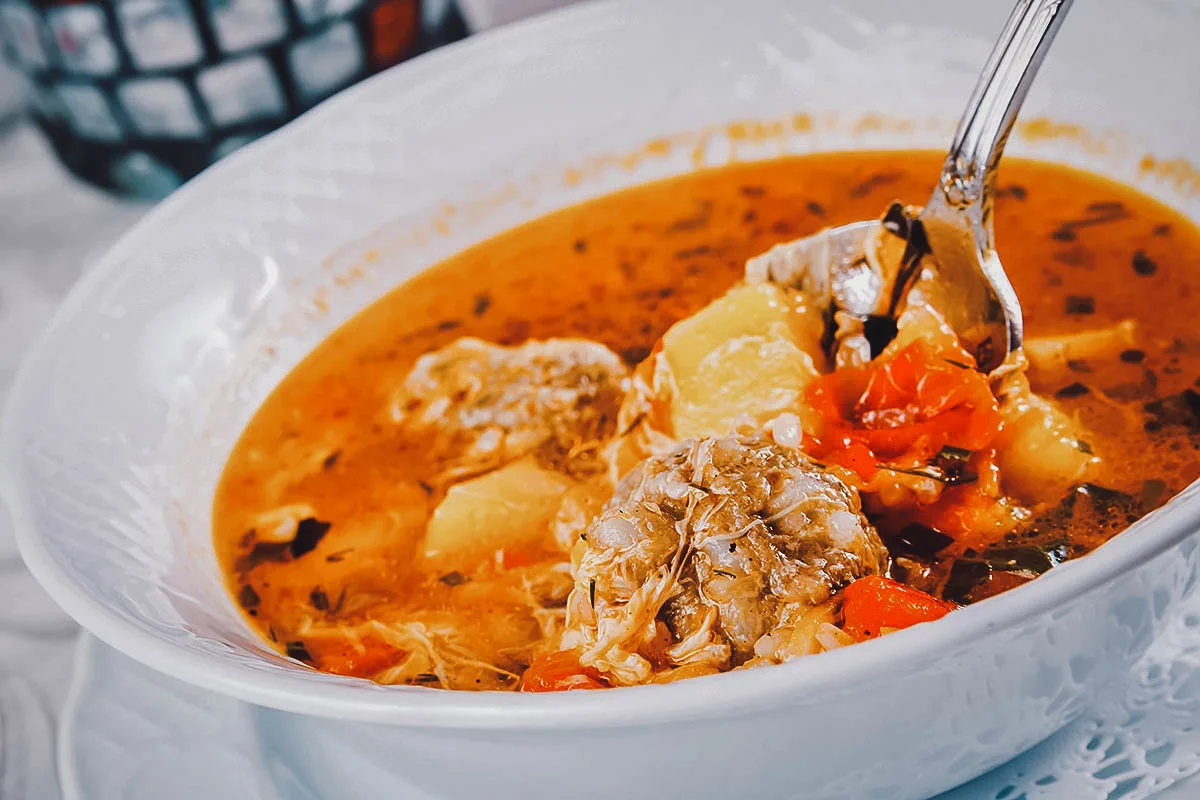
Photo by lvssvl1
7. Harissa
Not to be confused with the Tunisian hot chili pepper paste, harissa (or harisa) refers to a type of Armenian porridge made with stewed chicken and cracked or coarsely ground wheat. It’s one of the most popular dishes in Armenian cuisine and considered by many to be a national dish.
Originally, harissa was made with lamb but it’s now more commonly made with chicken. It’s traditionally served on Easter Day and on the third Sunday of September, to commemorate the Musa Ler resistance during the Armenian genocide in 1915. It’s a highly ritualistic dish that takes many hours to cook, its long cooking process being an essential part of the harissa tradition.
According to legend, the dish got its name from the patron saint of Armenia – Gregory the Illuminator. While serving a meal to the poor, they ran out of lamb so wheat was added to the pot. He noticed that the wheat was sticking to the bottom which prompted him to say: “Harekh! Stir it!”, and so was born the name of the dish – harissa. The dish has been offered as a charity meal ever since.
RECIPE: Harissa
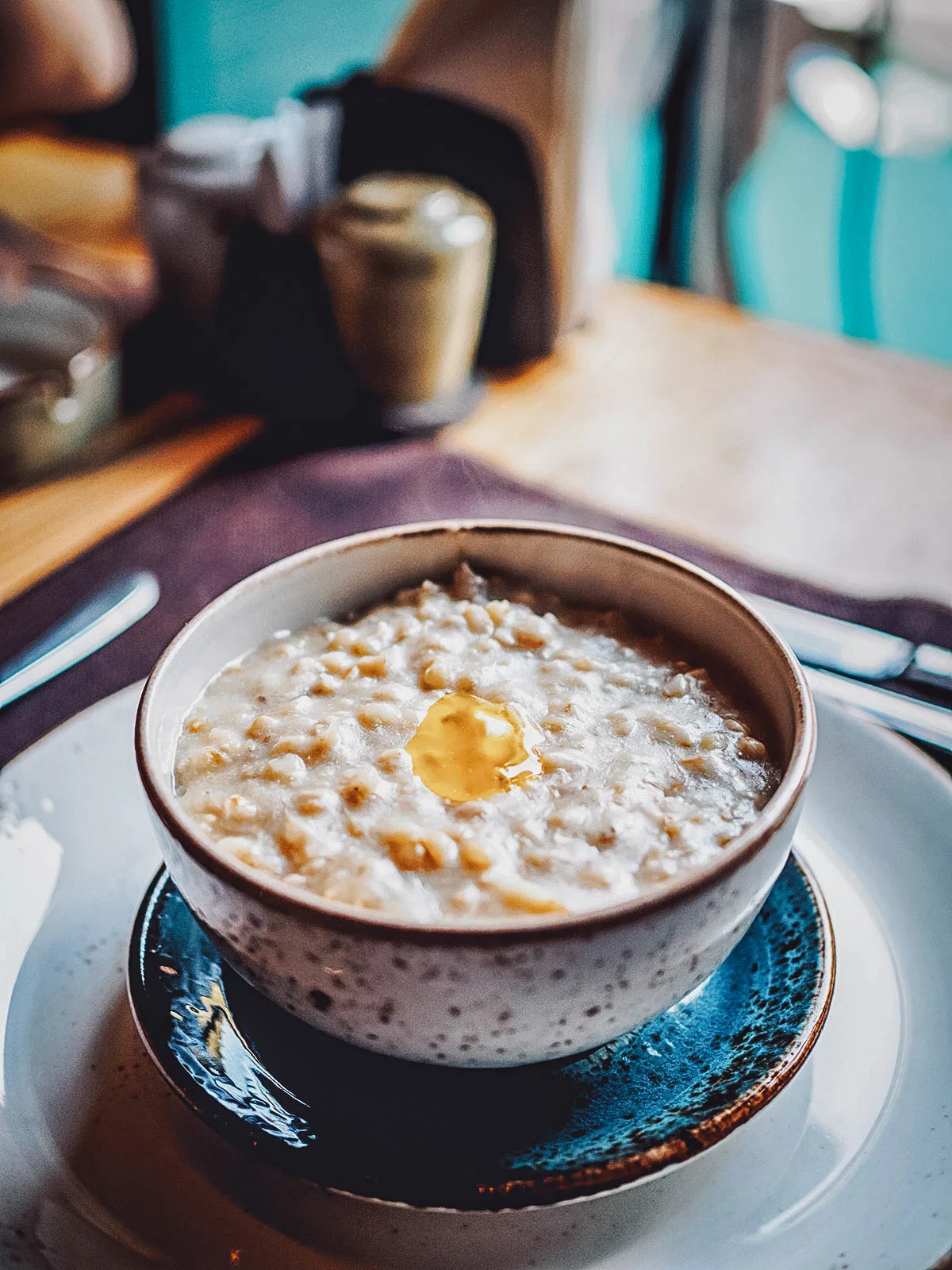
Photo by VickyDimBO
BREADS / PASTRIES / RICE
8. Lavash
Lavash refers to a thin traditional flatbread baked in a tonir (similar to tandoor) or on a saj. It’s one of the most widely consumed breads in Armenia, Azerbaijan, Turkey, Iran, Kazakhstan, and Kyrgyzstan.
Lavash can be made with leavened or unleavened dough. Toasted sesame and/or poppy seeds is sometimes sprinkled on the rolled out dough before it’s baked in a tonir. Traditionally, the dough is slapped to the inside of the oven but it can be cooked on a saj or pan as well.
Lavash is a versatile bread that can be used in many ways. When freshly made and still soft, it’s often used as a wrap for khorovats (a national dish of Armenia) or eaten for breakfast with eggs, cheese, jam, or butter. Dried lavash is crumbled to add more substance to khash, also an Armenian national dish. Lavash dries out quickly but it can be rehydrated with water to make it soft again so stacks of dried lavash (pictured below) are a common sight at Armenian markets.
Like many dishes from that region, lavash isn’t without its controversies. It was described by UNESCO as “an expression of Armenian culture” which drew ire from the citizens of Azerbaijan, Iran, Kazakhstan, and Kyrgyzstan who claimed that the dish was regional, not Armenian. Though often attributed to Armenia, some historians believe that it may have originated in the Middle East.
Regardless of where it’s originally from, you’re sure to encounter (and enjoy) lavash many times on your trip to Armenia.
RECIPE: Lavash
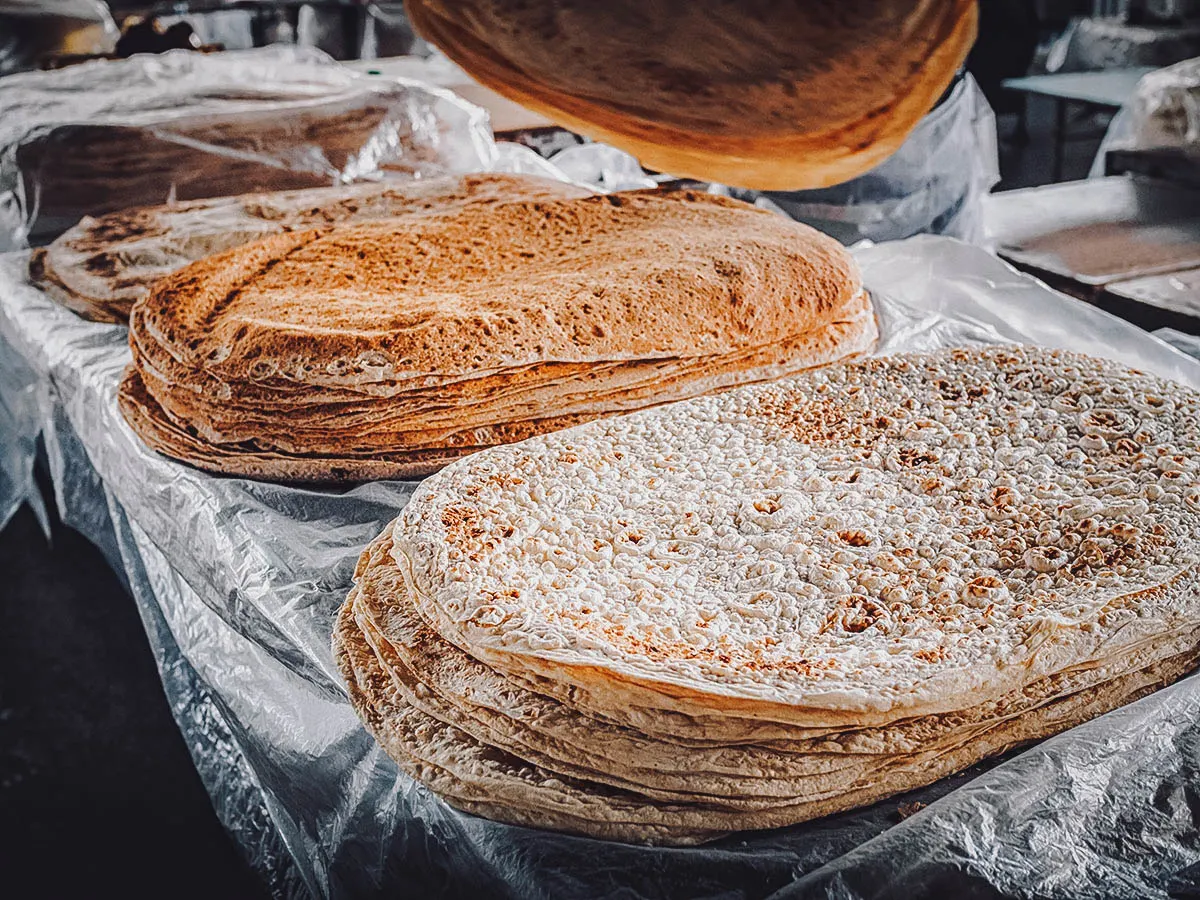
Photo by VickyDimBO
9. Matnakash
Matnakash refers to a type of traditional Armenian bread. It’s made with leavened wheat flour dough shaped into oval or round loaves with bold central ridges created by hand. In fact, the name matnakash literally means “finger draw” or “finger pull” in reference to how these ridges are made.
Matnakash gets its characteristic golden brown color and crispy crust from being brushed with a sweetened tea essence before baking. It can be eaten warm or at room temperature with different dipping sauces, soups, and stews.
RECIPE: Matnakash
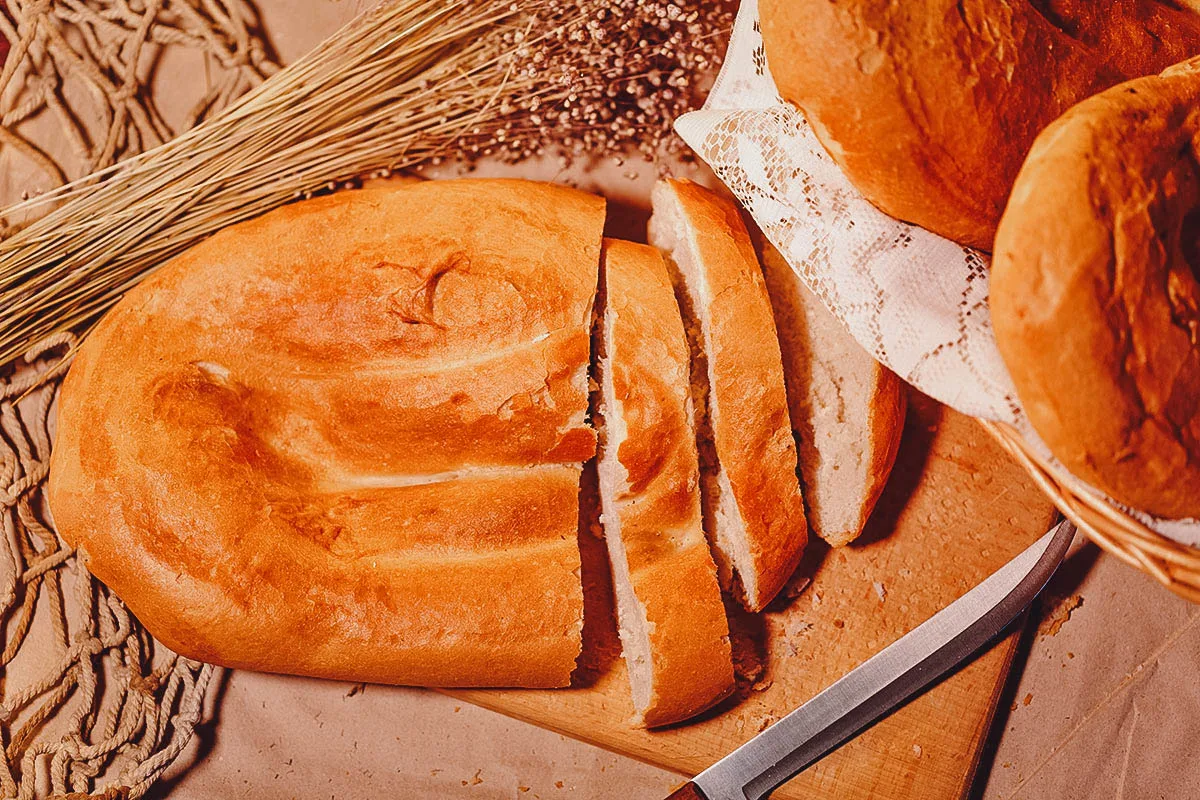
Photo by PavelTalashov
10. Gata
Gata refers to a family of Armenian dessert pastries. It exists in many variations throughout Armenia, with some towns and regions known for making their own unique version.
Traditionally, gata was baked in a tonir but modern versions are now baked in conventional ovens. They can be made in a variety of shapes and sizes and can either be plain or adorned with some type of pattern or decoration. They can resemble croissants or be formed into flattened discs (pictured below) about a foot in diameter. These disc-like versions of gata are often decorated before baking and tend to be sweeter and more cake-like in texture.
Regardless of its shape, some of the most popular versions of gata are filled with koritz (or khoreez), a sweet filling consisting of flour, butter, sugar, and vanilla. Some recipes add walnuts to the filling as well.
Gata is a popular Armenian dessert that’s typically eaten at festivities like the feast of Candlemas, but it can be enjoyed at any time of the year, often with coffee or tea.
RECIPE: Gata
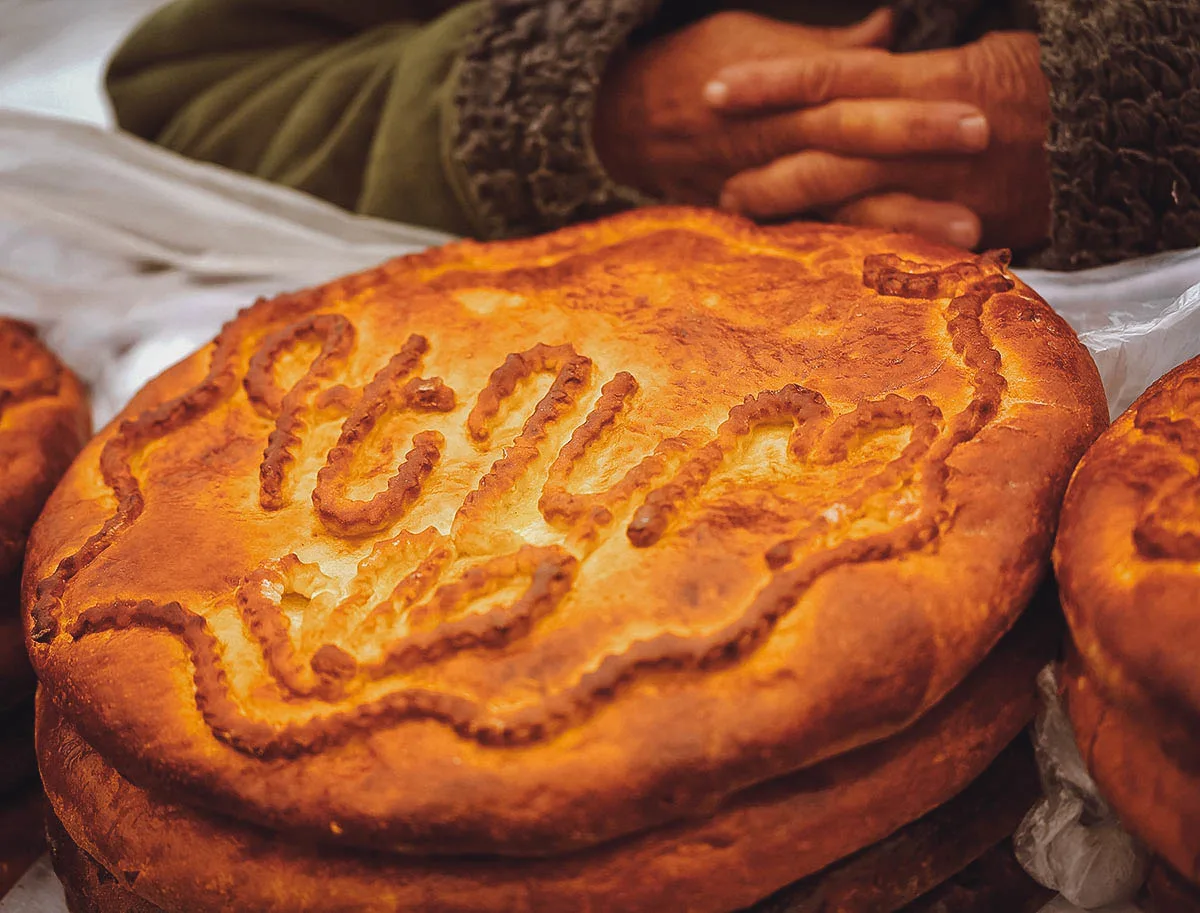
Photo by kostin77
These croissant-like versions of gata are made from an enriched bread dough rolled out into paper-thin sheets. The sheets are smeared with butter or koritz before being rolled up and cut into spirals. When baked, they puff up and become crispy on the outside and flaky on the inside, much like a croissant.

Photo by iko
11. Boereg
Boereg (or byorek) is the Armenian version of börek, a family of filled pastries popular in the cuisines of many countries in the South Caucasus, the Balkans, Central Asia, and the Levant. They consist of phyllo dough or puff pastry filled with a variety of ingredients like meat, cheese, spinach, or potatoes.
Börek exists in many different versions throughout the region. They can be made in various sizes and shapes and can be either savory or sweet. In Armenia, boereg is typically shaped into triangles and filled with cheese, spinach, or ground beef.
RECIPE: Cheese boereg
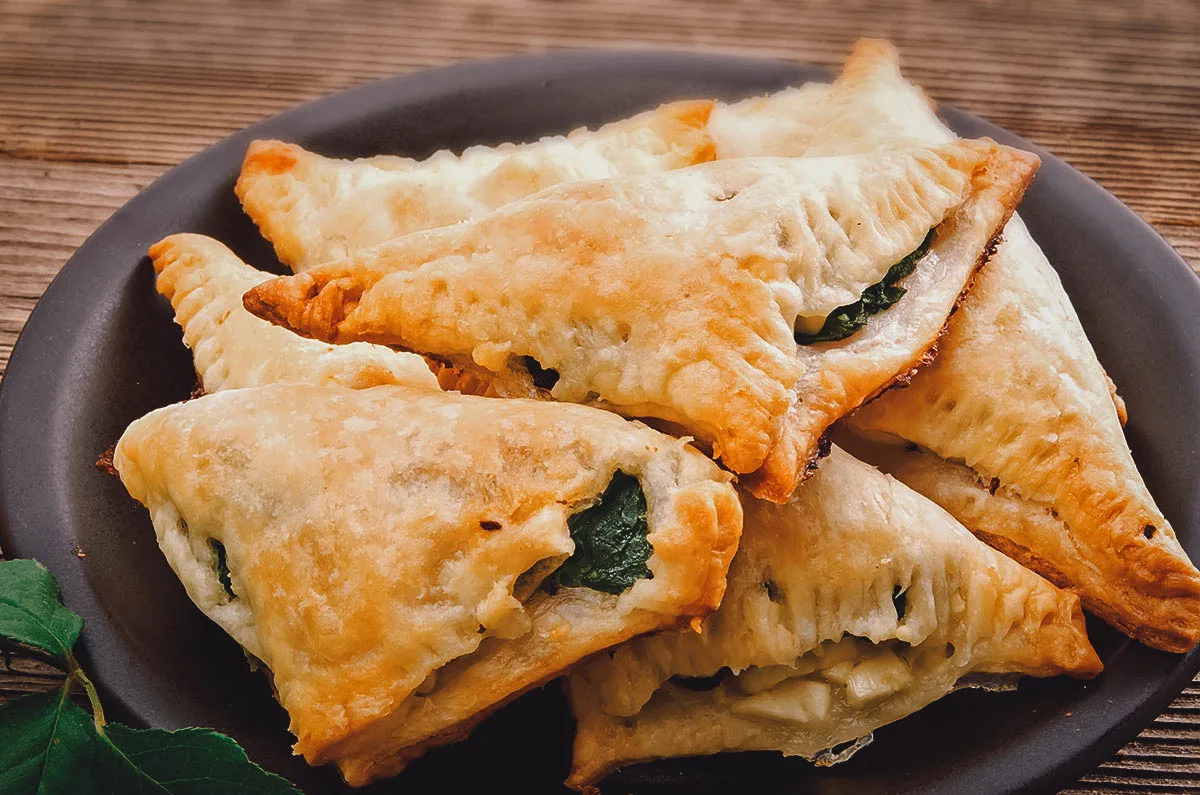
Photo by dar19.30
12. Lamadjo
Lamadjo is the Armenian version of lahmacun, a baked flatbread and spiced meat dish popular in Turkish cuisine. It consists of a thin layer of dough topped with minced meat (usually beef or lamb), herbs, and spices. Though it resembles a thin cheese-less pizza, it’s rolled up and eaten more like a wrap along with different vegetables like onions, tomatoes, peppers, eggplant, and pickles.
Lamadjo is a popular dish in Turkish and Armenian cuisine but it’s believed to have its roots in the Middle East. Flatbread had been used to wrap meat for thousands of years but it wasn’t until medieval times that the bread and toppings were baked together. This led to the creation of a dish called lahm b’ajin, which was later shortened to lahmajin and other similar names.
RECIPE: Lamadjo
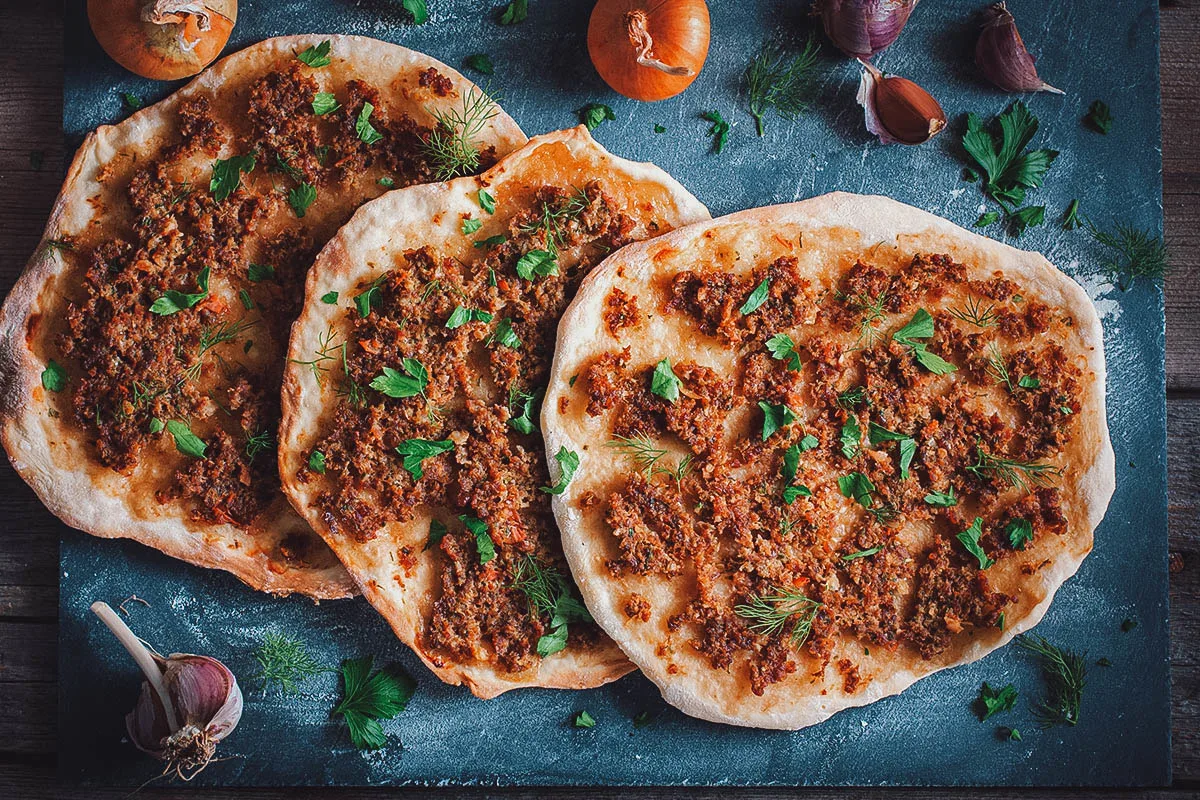
Photo by ann_1101.mail.ru
13. Zhingyalov Hats
Zhingyalov hats (or zhengyalav hatz, jingalov hats) refers to a traditional Armenian flatbread dish made with finely diced herbs and vegetables. It’s originally from the Artsakh and Syunik provinces of Armenia and can be considered a type of herb-filled lavash.
To prepare, unleavened dough is rolled out until its paper thin before being filled with a mix of 10-20 types of diced and oiled herbs and vegetables. Milder-tasting herbs and greens like spinach, lettuce, chickweed, and viola leaves form the base while stronger and more potent herbs like chervil, urtica, and taraxacum are used in smaller quantities to add a punch of flavor.
After the dough is stuffed with the herb mixture, it’s fried on a saj or in a tonir before being consumed with beer, wine, or doogh (yogurt-based drink). Zhingyalov hats are especially popular during the Great Lent but they can be eaten at any time of the year.
RECIPE: Zhingyalov hats
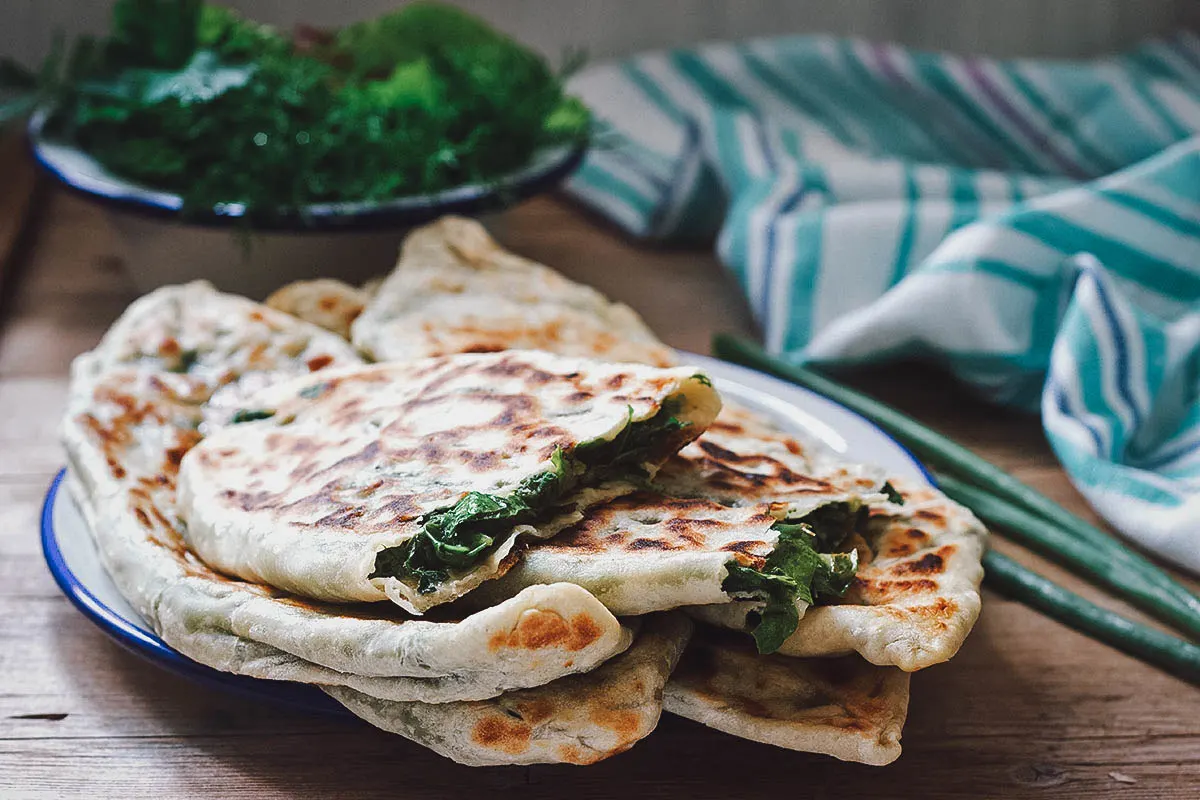
Photo by danilovajanna
14. Pilaf
Pilaf refers to a family of rice dishes popular in many parts of the world, most notably Central Asia, Iran, Turkey, India, and the Caribbean. It consists of long-grain rice cooked in stock or broth with fried onions, vegetables, meat, and fragrant spices like cardamom, bay leaves, and cinnamon.
There are thousands of variations of pilaf around the world but in Armenia, some of the most common are made with rice cooked in stock seasoned with a variety of spices like mint, parsley, oregano, and allspice. Some Armenian recipes may replace rice with bulgur or orzo while others may just incorporate them into the dish along with vermicelli noodles. Pictured below is a type of Armenian pilaf made with liver.
RECIPE: Armenian pilaf
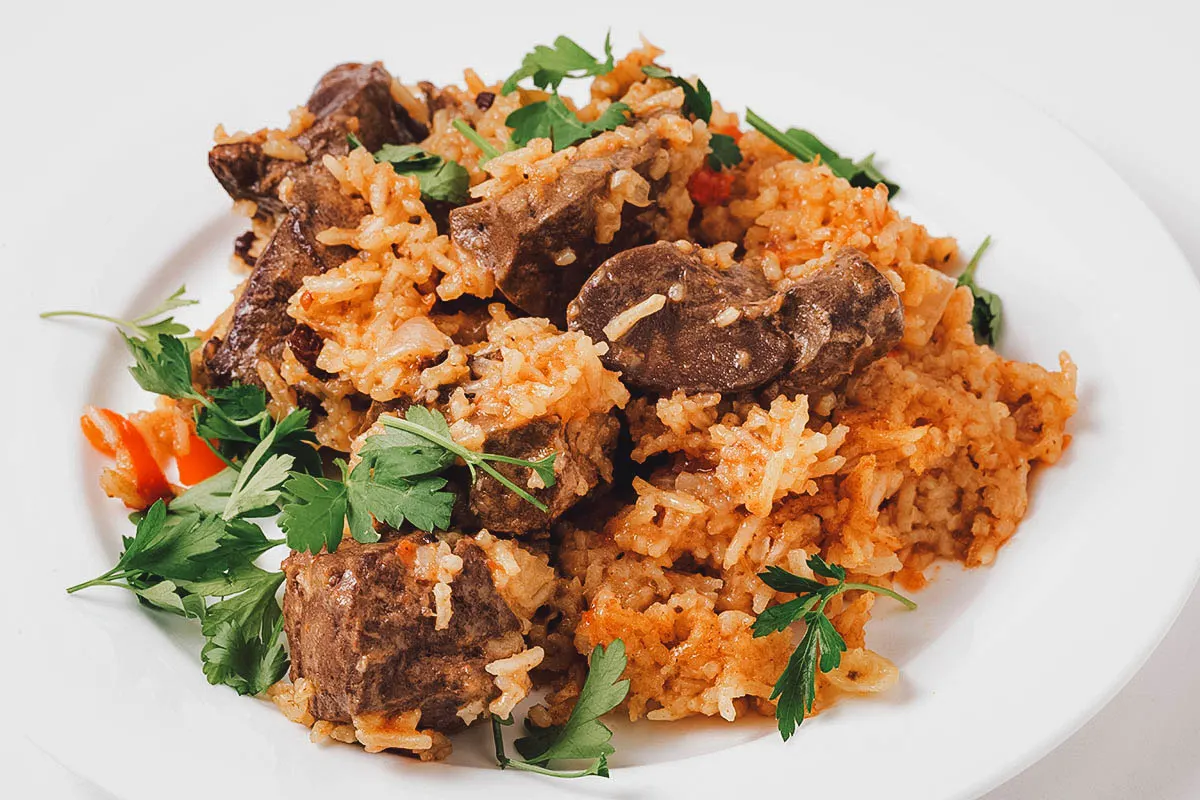
Photo by Paul_Cowan
VEGETARIAN / DAIRY
15. Ghapama
Ghapama refers to an Armenian stuffed pumpkin dish. It’s made with a hollowed out pumpkin filled with boiled rice and dried fruits like chopped apples, apricots, plums, dates, and raisins. It can be sweetened with honey, ground cinnamon, or sugar before being baked in a tonir.
To serve, the cooked and softened pumpkin is brought to the dinner table where it’s cut down the sides so it opens up like a flower. Popular at weddings and holidays like Christmas and New Year, it can be served as part of the main meal or for dessert. Dessert ghapama are usually made sweeter than versions eaten with meals.
RECIPE: Ghapama
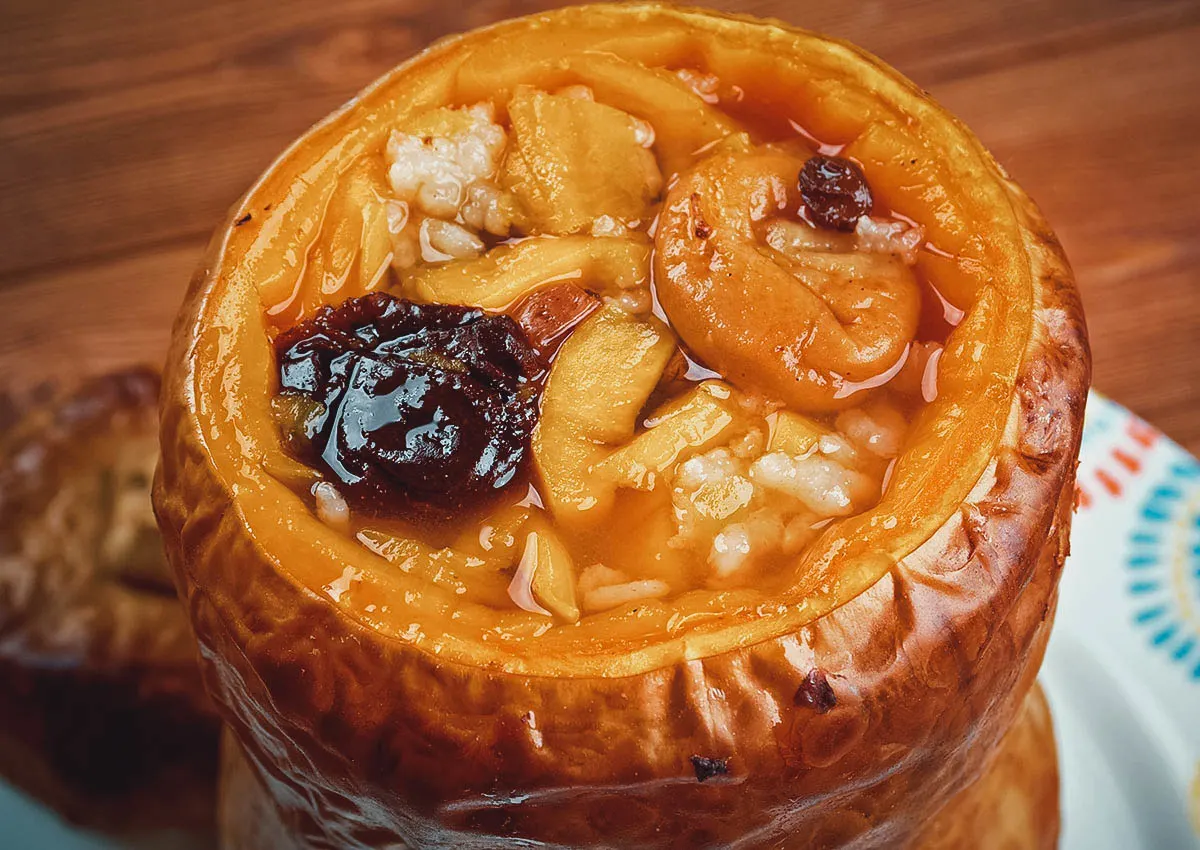
Photo by fanfon
16. Topik
Topik (or tobig) refers to an Armenian vegan dish traditionally served during Lent. It’s made with a chickpea and potato paste filled with a cooked mixture of onions, currants, nuts, tahini, herbs, and spices. They’re typically formed into patties or balls and topped with pine nuts, currants, cinnamon, and lemon.
RECIPE: Topik
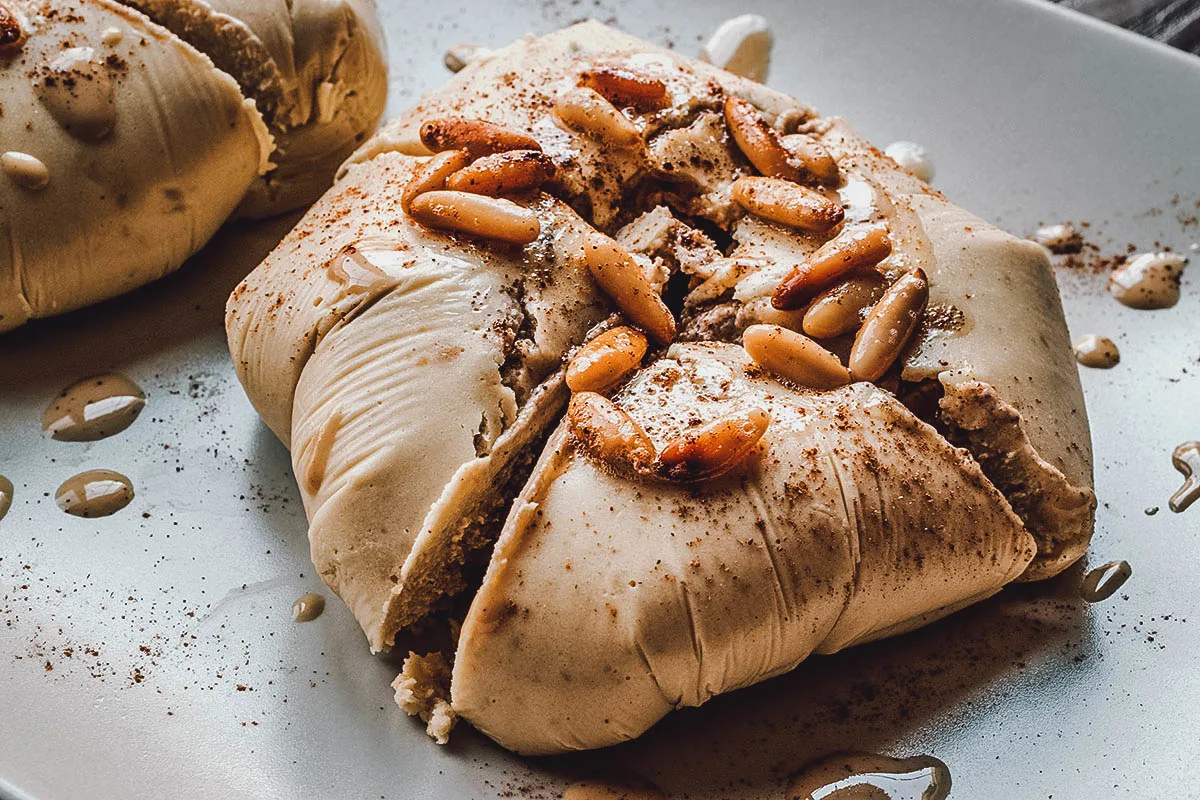
Photo by Alp_Aksoy
17. Chechil
Chechil (or husats, tel) refers to a type of brined and smoked Armenian string cheese. Produced in the Armenian Highlands, it’s similar in consistency to mozzarella or sulguni and is often sold in thick braided ropes.
Chechil is a low-fat cheese made from pasteurized cow’s milk. To make, curd is heated to high temperatures which allows is to be stretched and kneaded to the desired consistency. The cheesemaker will pull the cheese into thin dense strings before maturing them in brine. The strings are then smoked and braided together by hand into thick ropes before being sold.
Popular throughout Central Asia, Eastern Europe, and the US, chechil is a salty, smokey, and chewy snack that goes very well with beer. Its low fat content also makes it an ideal diet food.
RECIPE: Chechil
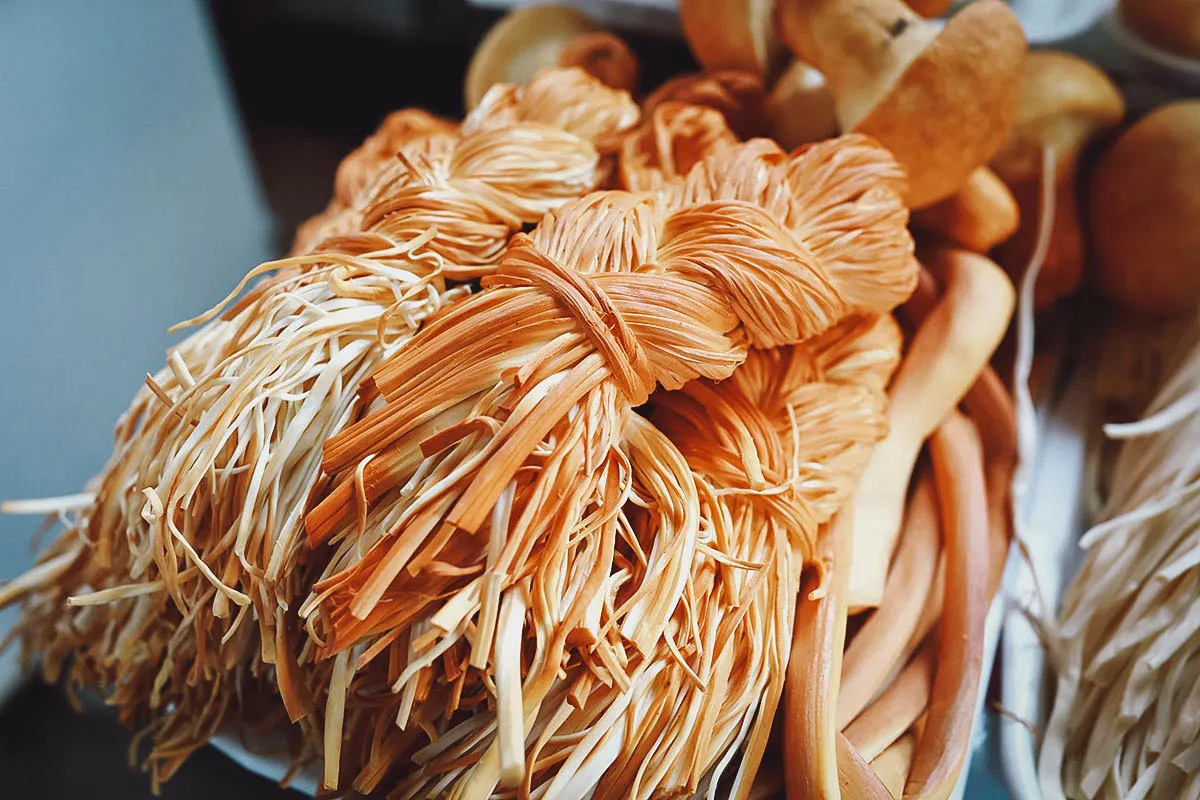
Photo by AChubykin
18. Matsun
Matsun (or matzoon, matsoni) refers to a centuries-old fermented milk product originally from Armenia. Similar to yogurt, it’s made primarily with cow’s milk but it can be made with goat, sheep, or buffalo milk (or a mixture) as well.
To prepare, a mixture (meran) made with dried cornelian cherry fruits, wheat, and rye is used as a starter. Natural rennet is produced by placing small pieces of cattle intestine inside gauze and then immersing it in boiling milk. The rennet is later removed and the pot with fermented milk is left under a blanket overnight before the matsun is ready for consumption the following day.
Matsun has long been an important part of the Armenian diet. It’s used in the production of butter. It can be eaten with or without bread and used as an ingredient in many Armenian soups, salads, fillings, and drinks.
When dried, matsun is turned into a longer-lasting product called kamats matsun. To preserve it for even longer, it’s turned into cioratan by forming the kamats matsun into little balls and then leaving them under the sun or baking them in an oven. Cioratan lasts for years and can be rehydrated with water when they’re ready to be consumed.
RECIPE: Matsun
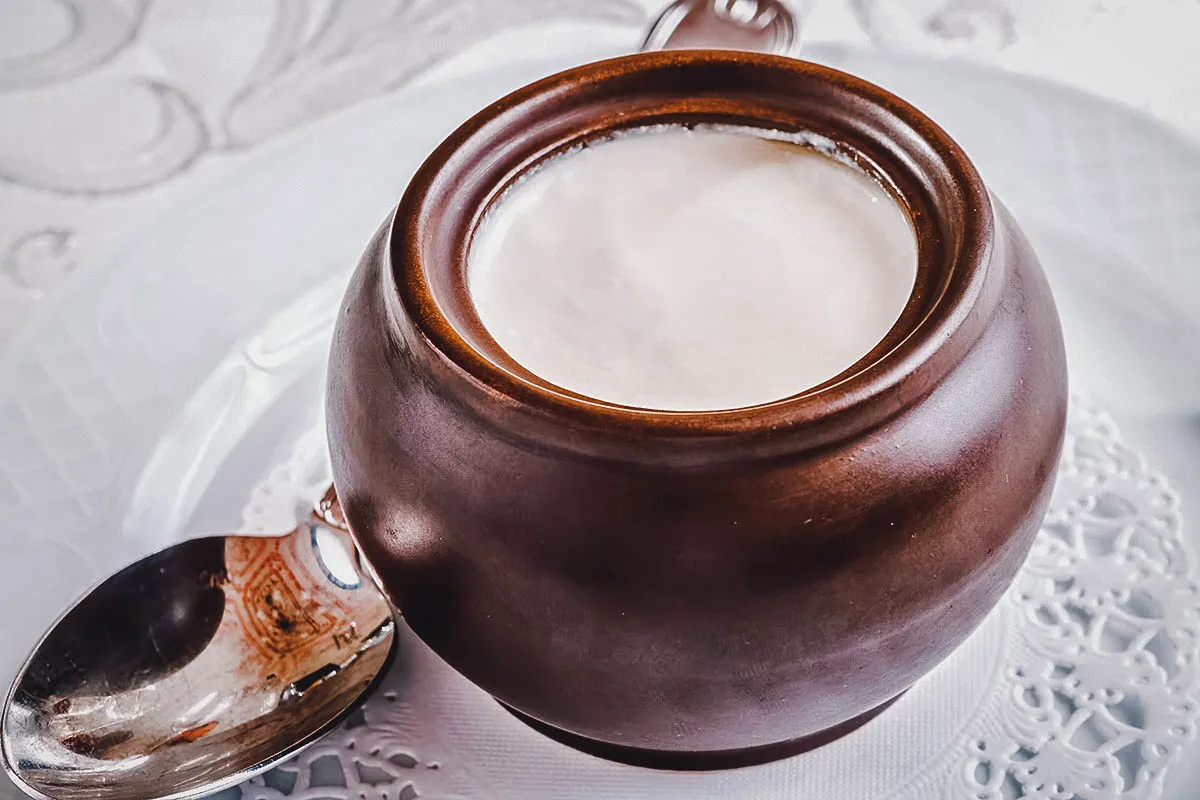
Photo by lvssvl1
19. Matsnaprtosh
Matsnaprtosh is a matsun-based Armenian soup made with mostly raw vegetables like finely chopped cucumbers, green onions, radish, and dill. It can be made with other ingredients as well like garlic, boiled potatoes, eggs, and cooked meats like ham, beef, veal, or sausage.
Matsnaprtosh is very similar to Russian okroshka but it’s generally made with fewer vegetables. Like okroshka, it’s a refreshing cold soup that’s typically enjoyed in the summer.
RECIPE: Matsnaprtosh
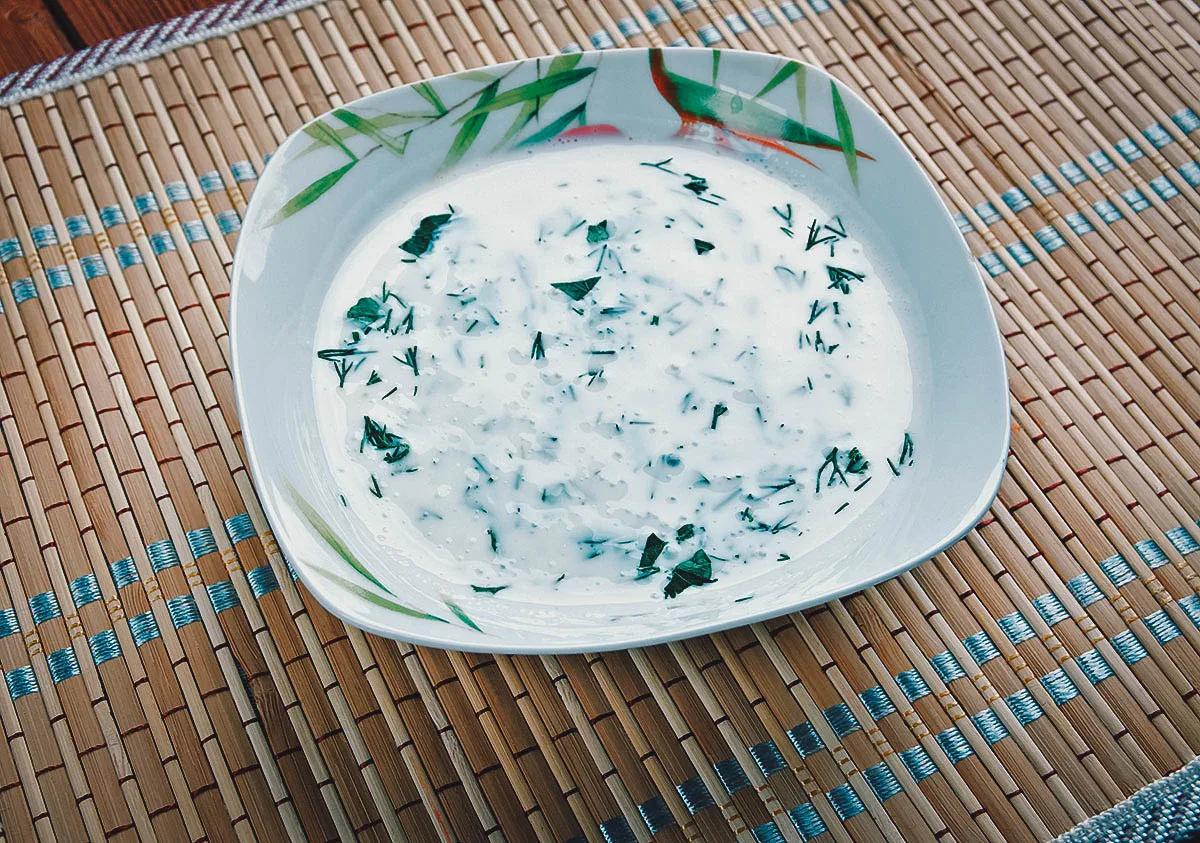
Photo by fanfon
MEAT
20. Khorovats
If you enjoy barbecued meats, then you’re going to love khorovats. It’s the Armenian version of shish kebab or shashlik made with skewered cubes of meat grilled over an open flame. The word khorovats means “grilled” in Armenian.
Khorovats can be made with different types of meat but pork is most commonly used. Recipes vary but it’s typically made with bony, slightly fatty pieces of pork marinated in a mixture containing salt, pepper, garlic, onion, herbs, and other ingredients. Vinegar is never used because it changes the flavor of the meat.
The marinated meats are skewered on flat shish or shampoor (skewer) before being grilled over charcoal on a khorovats-style grill called a mangal. Unlike American-style grills, it doesn’t have a grate so the meats are cooked directly over the coals. Vegetables like tomatoes, onions, and peppers are also grilled on the mangal but not on the same skewers as the meat.
Khorovats is an Armenian national dish, one that’s near and dear to the hearts of many locals. During the Soviet era, meat was already scarce but it became even more of a rarity during the post-Soviet era of the 1990s. Today, to invite people over for khorovats meant that life was good. It’s become a celebratory dish often reserved for special occasions.
RECIPE: Khorovats
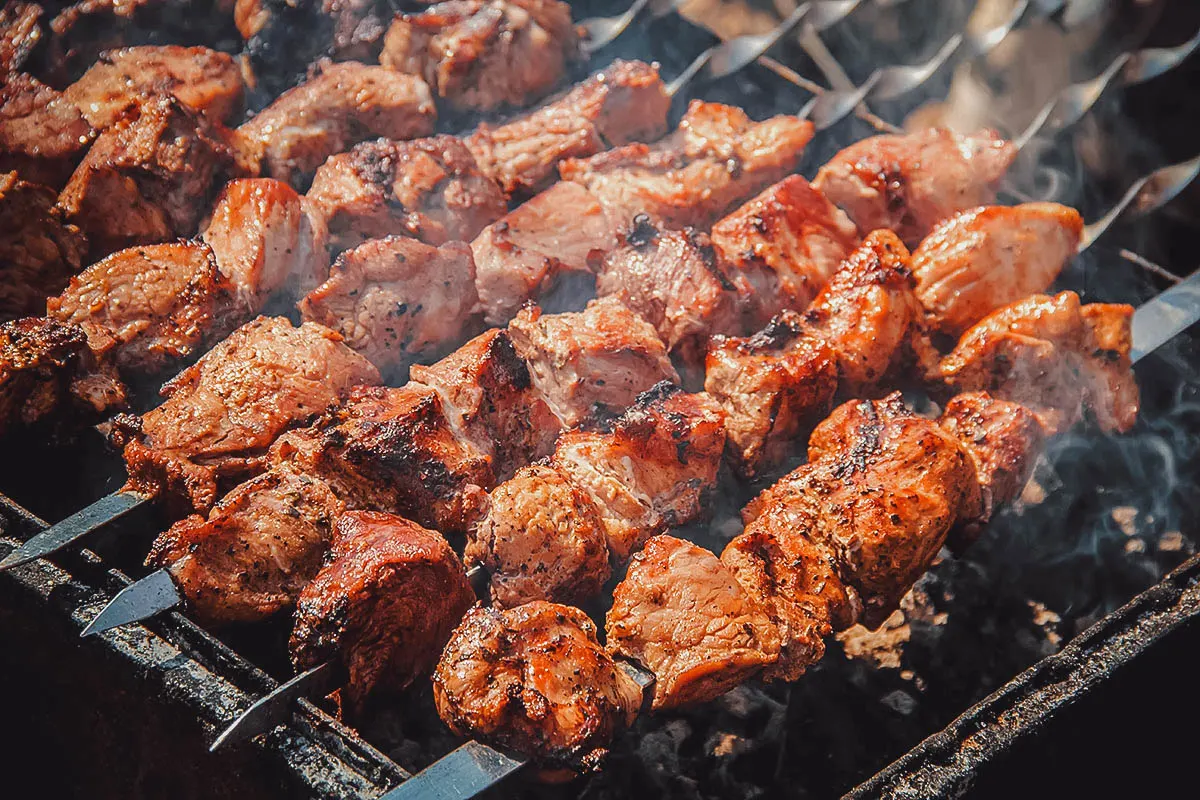
Photo by [email protected]
21. Lule Kebab
Lule kebab (or lyulya kebab) refers a type of skewered minced meat kebab popular in Armenia and Azerbaijan. It can be made with different types of meat like beef, lamb, or mutton ground with onions, herbs, spices, and seasonings. The mince is wrapped into oblong shapes around skewers and then grilled on a mangal.
Lule kebab is often eaten wrapped inside lavash with vegetables and herbs like roasted peppers, tomatoes, onions, and parsley. A sprinkling of sumac can also be added for an extra kick of flavor.
RECIPE: Lule kebab
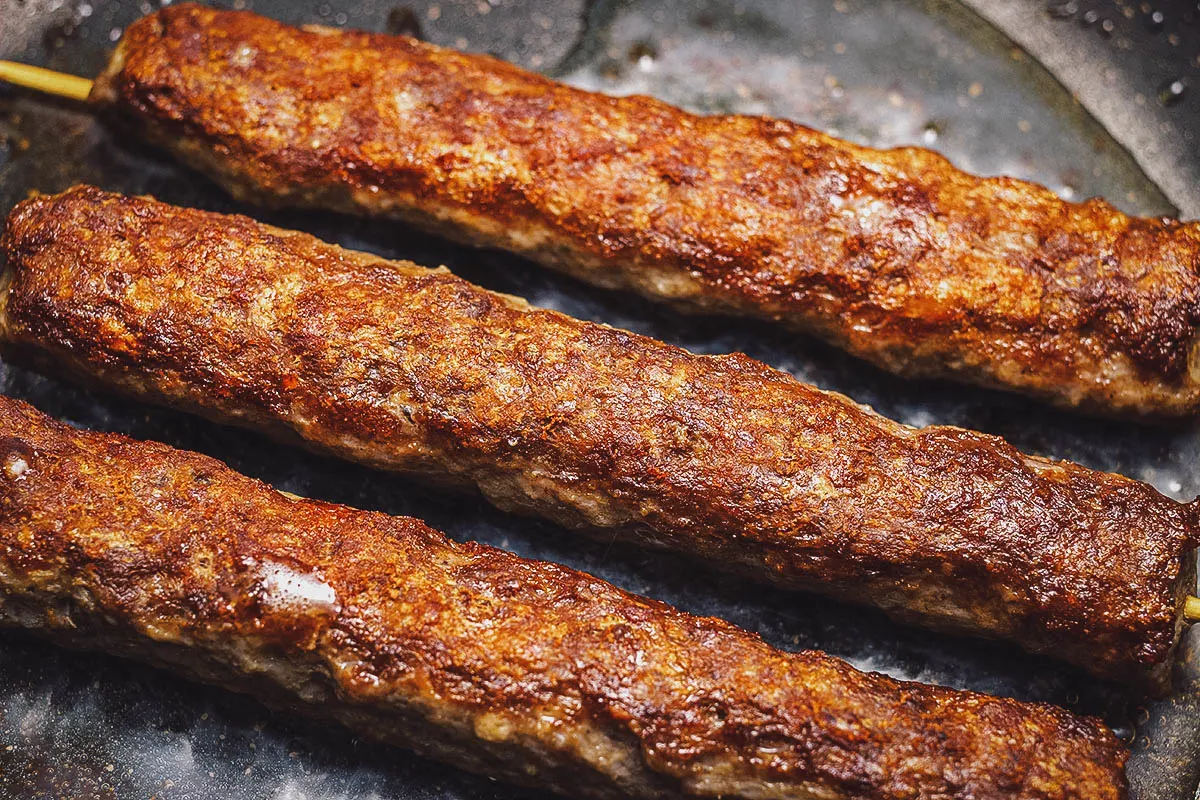
Photo by pavlofox
22. Chi Kofte
If you enjoy eating raw meat and fish, then you’re probably going to find chi kofte interesting. It’s like an Armenian version of steak tartare made with raw ground meat (usually beef, lamb, or goat) and bulgur. It’s the same dish as Turkish çiğ köfte and a close relative of Lebanese kibbeh nayyeh.
To prepare, very fresh meat is ground several times until it achieves a paste-like consistency. It’s then mixed with bulgur and a host of herbs and spices before being formed into oblong-shaped patties by hand. They’re lightly shaped in the fist which is what gives them their characteristic indentations.
Because chi kofte is made with raw beef, it needs to be consumed on the same day. It’s drizzled with lemon and olive oil and usually eaten with gheyma, salata (fresh salad), or both. Gheyma refers to an Armenian side dish made with ground beef cooked with onions and parsley.
RECIPE: Chi kofte
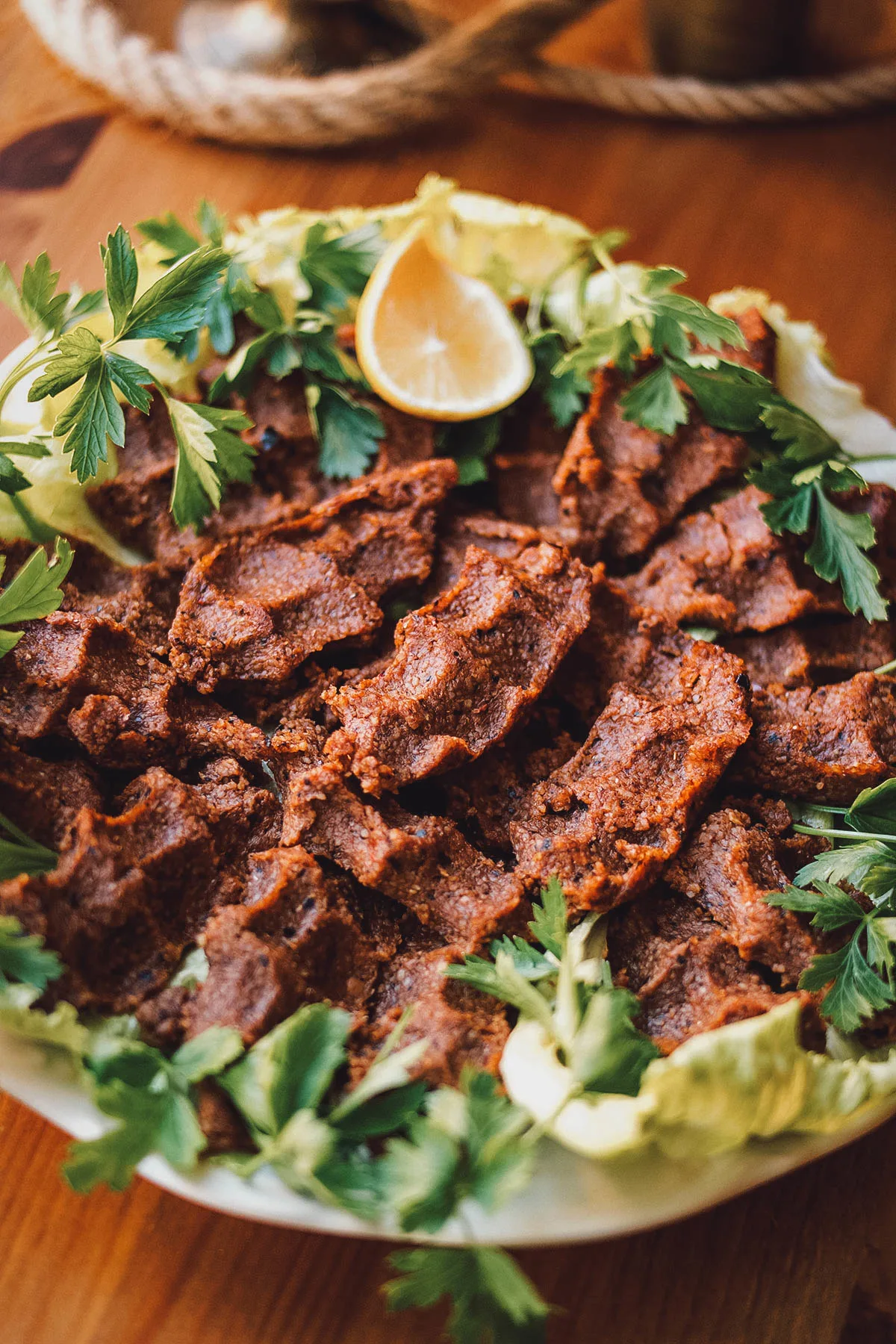
Photo by Alp_Aksoy
23. Khashlama
Like khorovats, khashlama is considered a celebratory dish in Armenia, one that’s usually reserved for special occasions. It’s a type of meat stew that’s traditionally made with boiled lamb though it can be made with beef as well. The name khashlama is derived from the Armenian word khashel, meaning “to boil”.
Khashlama consists of bone-in lamb boiled in a flavorful broth with vegetables and root crops like tomatoes, onions, and potatoes. In the summer, it’s often made with summer vegetables like bell peppers, eggplant, and fresh herbs. It actually started off as a summer dish to coincide with the slaughtering of lambs and the harvesting of fresh vegetables.
I don’t know how true this is but it’s said that men seldom cook in Armenia because they reserve their energy for big dishes like khashlama and khorovats. They make them just once a year, usually outdoors and in the summer, to make the dishes that much more special.
Khashlama is equally popular in Georgia with both countries claiming to have invented the dish.
RECIPE: Khashlama
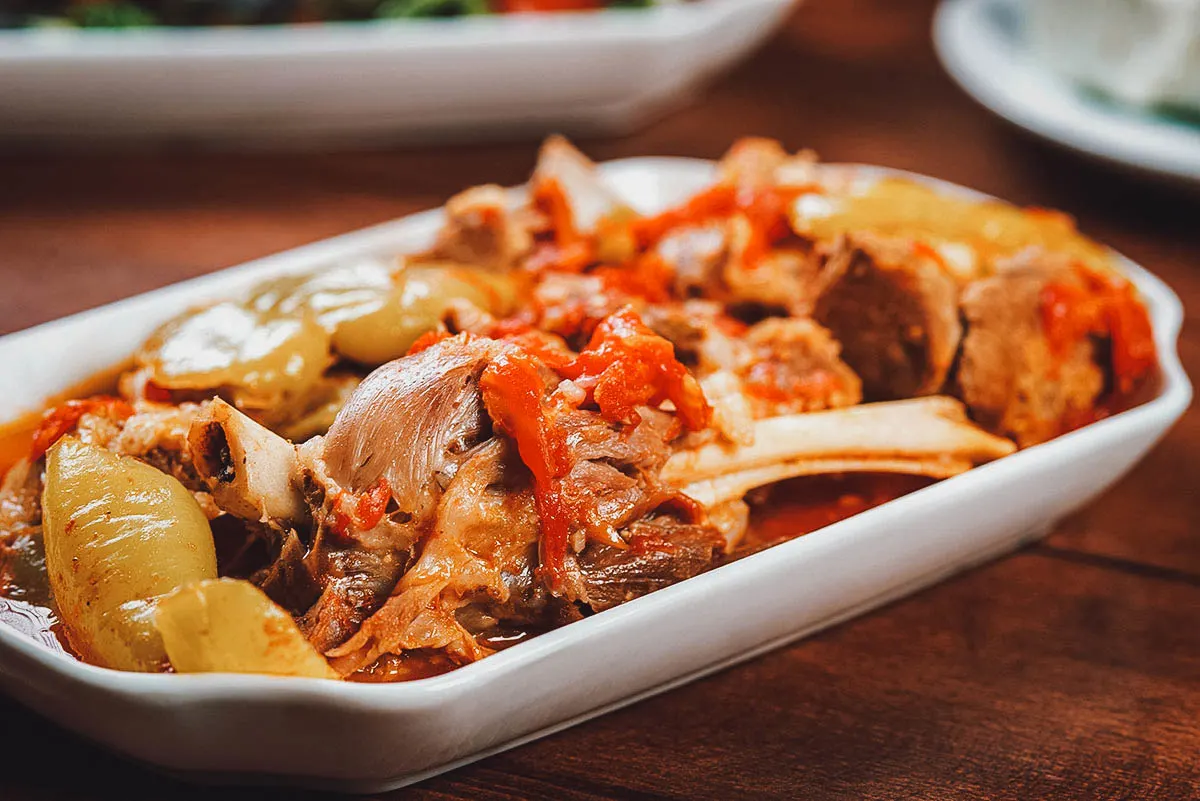
Photo by vigenmnoyan.gmail.com
24. Khash
If your head feels a little heavy after a night out in Yerevan, then you may want to tuck into a bowl of khash, Armenia’s miracle hangover cure of boiled cow hooves. It’s an Armenian national dish that exists in various forms throughout the South Caucasus, the Balkans, Central Asia, and the Levant.
Khash is traditionally made with boiled down cow hooves but it can contain other parts as well like the head and tripe. It was traditionally served in winter, usually in the morning with mulberry vodka. Like khashlama, it’s name is derived from the Armenian word khashel, meaning “to boil”.
To prepare, the cow’s hooves are cleaned, cut, and soaked in cold water for a day to remove any impurities and foul odors. They’re then boiled overnight until the water becomes thick and gelatinous and the meat is fall-off-the-bone tender. It’s customary to offer a series of toasts when eating khash, one of which goes to the cook to acknowledge the hard work that goes into making this beloved Armenian dish.
Khash is served with a variety of condiments and sides like garlic, radish, lemon, vinegar, and cinnamon. It’s also served with dry and fresh lavash. Dry lavash is crumbled into the soup to give it more substance while soft lavash is used as a wrap for eating and to cover the bowl to seal in the heat.
RECIPE: Khash
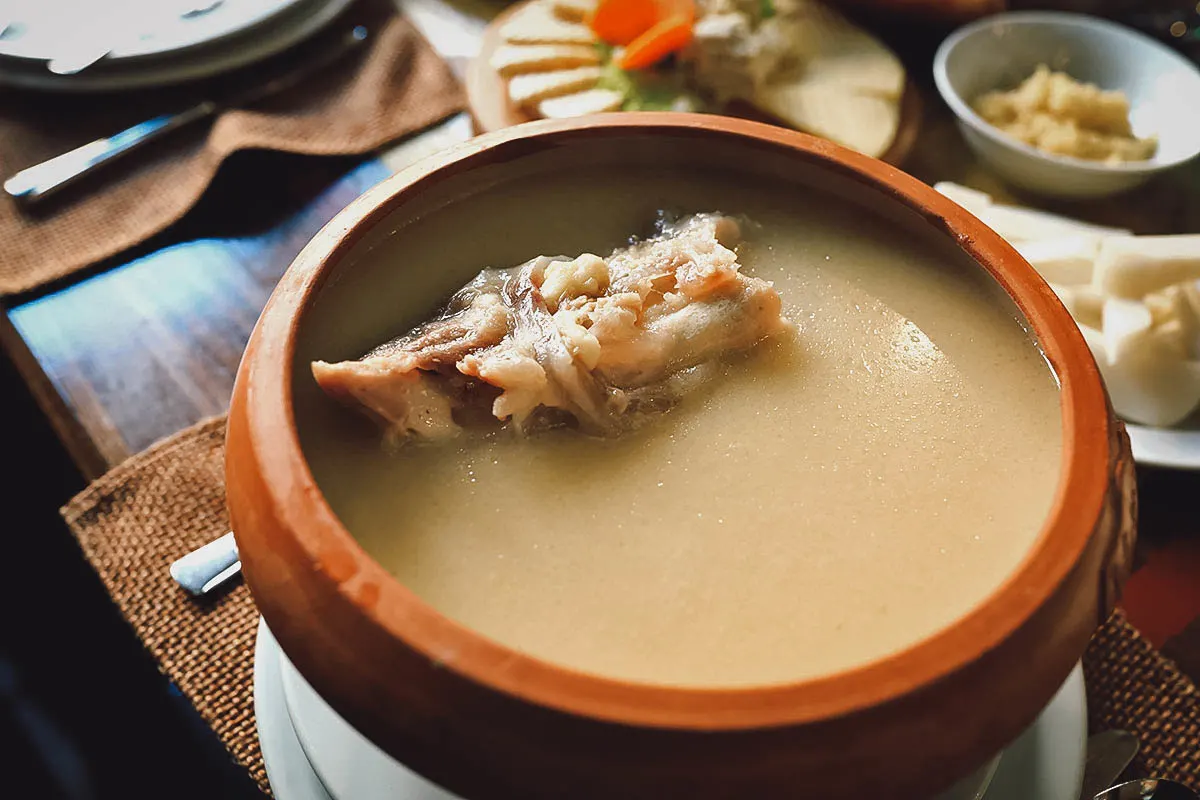
Photo by AChubykin
25. Tjvjik
Tjvjik refers to an Armenian offal dish. Traditionally, it was made with just beef liver fried with onions, but more modern versions are now made with additional ingredients like tomato paste, vegetables, fresh herbs, and other types of offal. It’s usually eaten with lavash, rice, or potatoes.
RECIPE: Tjvjik
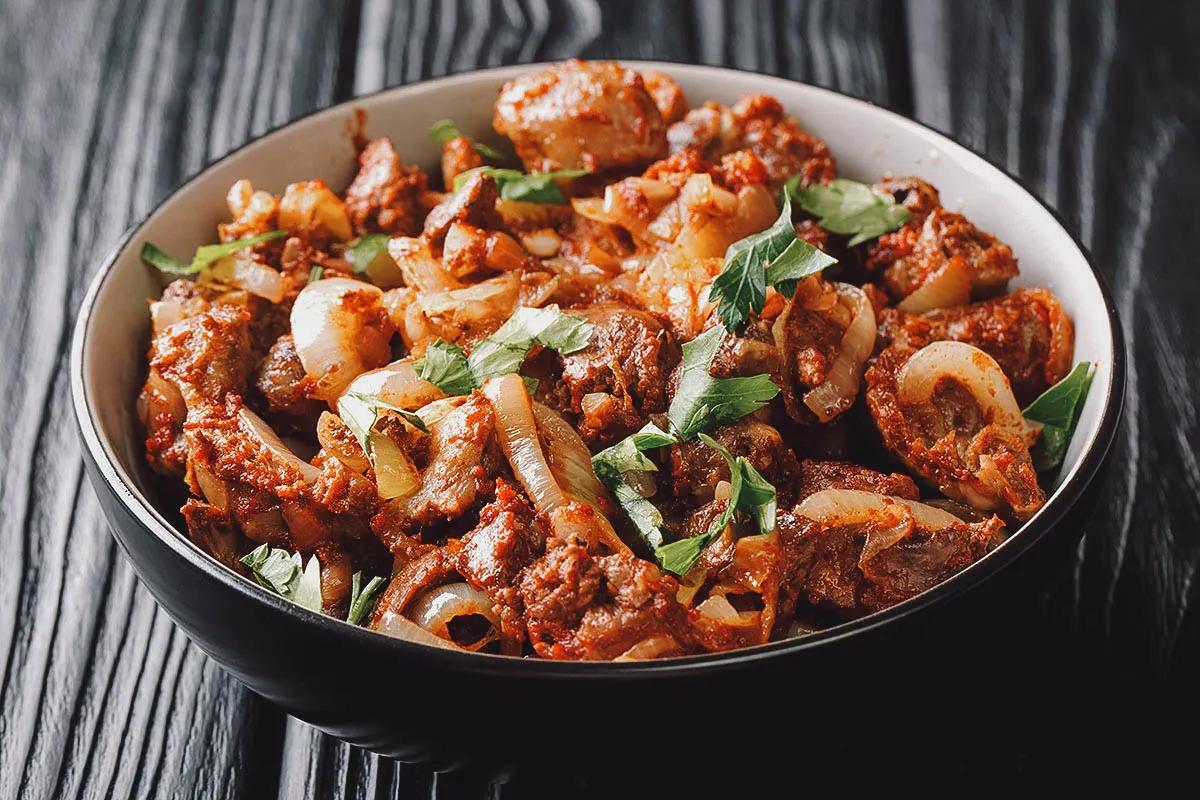
Photo by lenyvavsha
DESSERTS
26. Pakhlava
Pakhlava (or paklava) is the Armenian version of baklava, a hugely popular dessert consumed in many countries throughout the the South Caucausus, the Balkans, the Middle East, and Central Asia. Like lavash, it’s a beloved but contentious dish claimed by many countries.
At its core, pakhlava is a layered dessert made with multiple sheets of phyllo pastry filled with chopped nuts and sweetened with syrup or honey. Many variations of this dessert exist but Armenian pakhlava is typically sweetened with a simple syrup spiced with cloves and cinnamon.
Cut into diamond shapes, pakhalava is especially popular during the holidays. It’s a mainstay on the Armenian Christmas table and often consumed to celebrate Easter as well.
RECIPE: Pakhlava
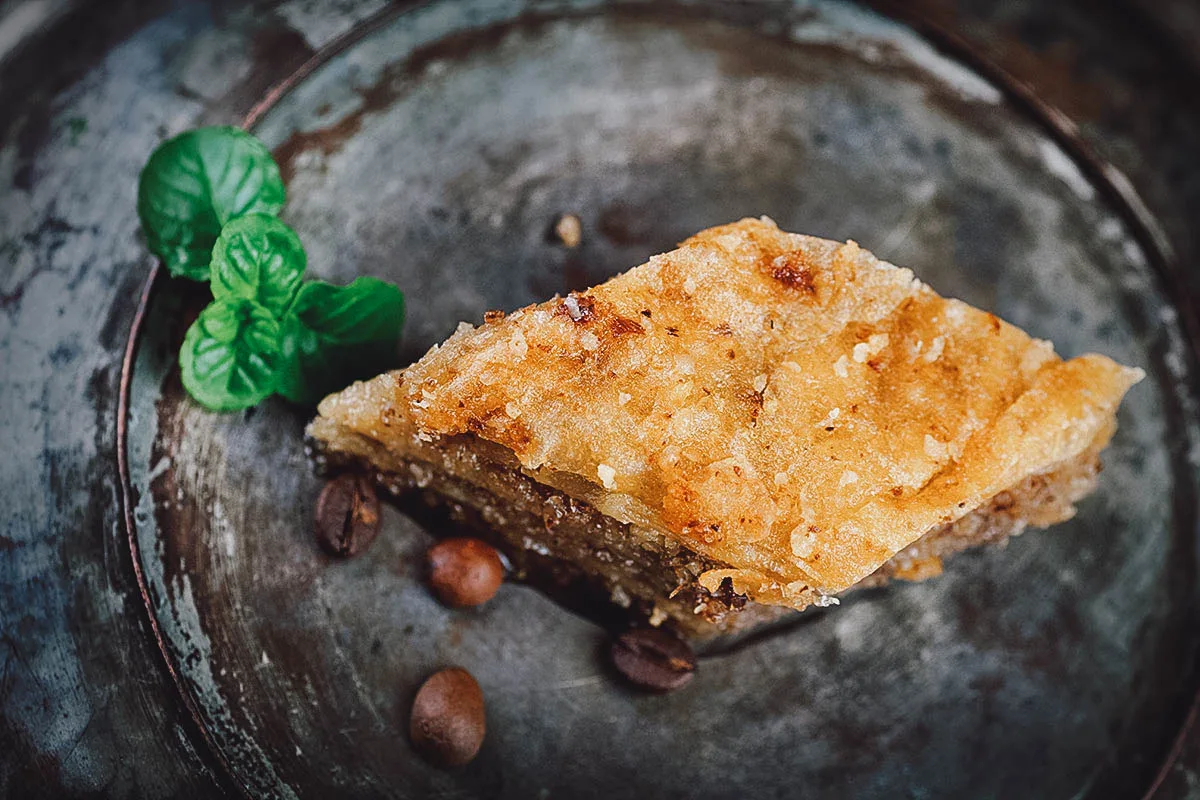
Photo by mythja
27. Mikado Cake
This cake may sound Japanese but it’s 100% Armenian. Not only is it an authentic Armenian dish, but it’s said to be one of the oldest Armenian classic cake recipes.
Mikado cake is a type of Armenian layer cake. Recipes vary but it basically consists of multiple thin cake layers frosted with chocolate custard or caramel buttercream. To decorate, the cake can be dusted with chocolate shavings or powdered cocoa. Not exactly the most diet-friendly dish but probably not something you’re likely to resist.
RECIPE: Mikado cake
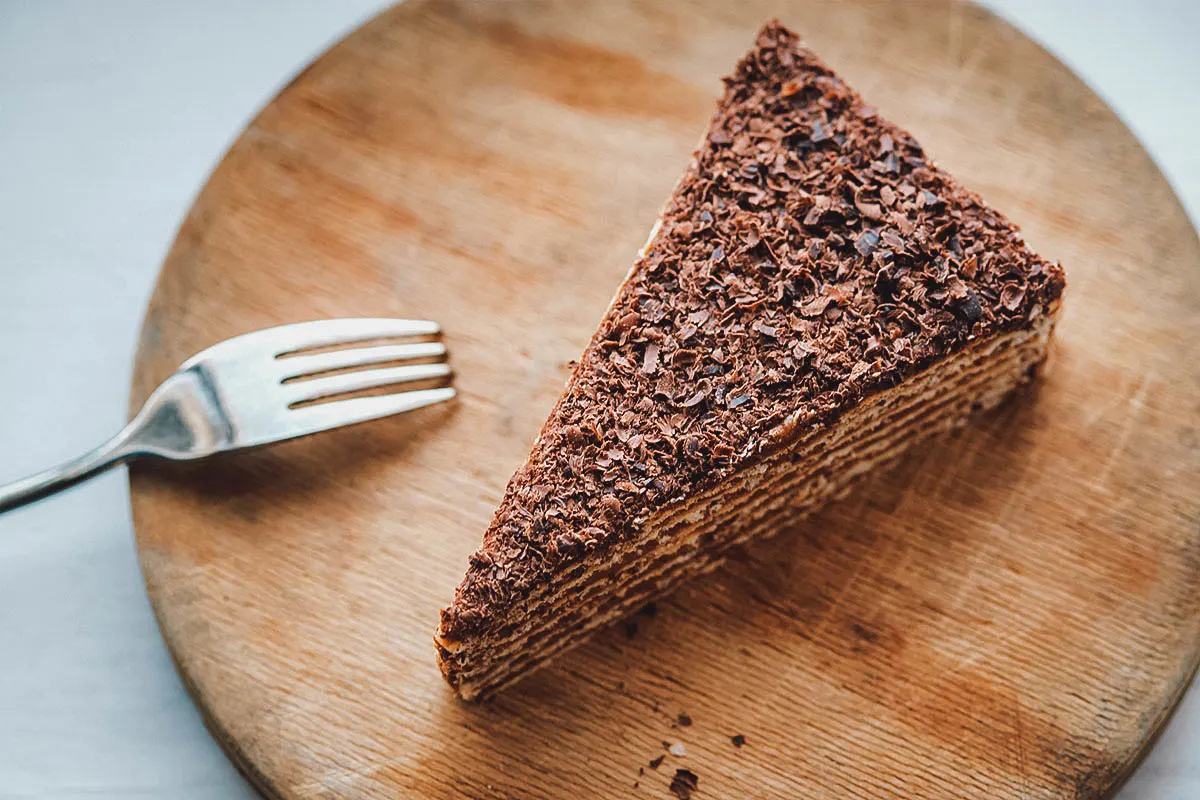
Photo by vigenmnoyan.gmail.com
28. T’tu Lavash
T’tu lavash (or pastegh, bastegh) is the Armenian version of fruit leather. Sold in different colors, they look like giant rolls of Fruit Roll-Up. It’s name literally means “sour lavash” and is in reference to the thin, easily rolled flatbread popular in Armenian cuisine.
T’tu lavash is popular in many countries where it goes by different names like tklapi (Georgia), pestil (Turkey), lavashak (Iran), and amerdeen (Arab world). Following an ancient method of fruit preservation, it’s made by sun-drying pureed fruit like grapes, plums, cherries, and apricots into thin leather-like sheets. It can be eaten as is or used as an ingredient in Armenian soups like t’ghit.
Local tip, if you’re staring at a basket of t’tu lavash and unsure which one to get, then ask for the one made with apricots. Locals are especially proud of the Armenian apricot (Prunus armeniaca) which is considered a national symbol of Armenia.
RECIPE: Armenian apricot fruit leather
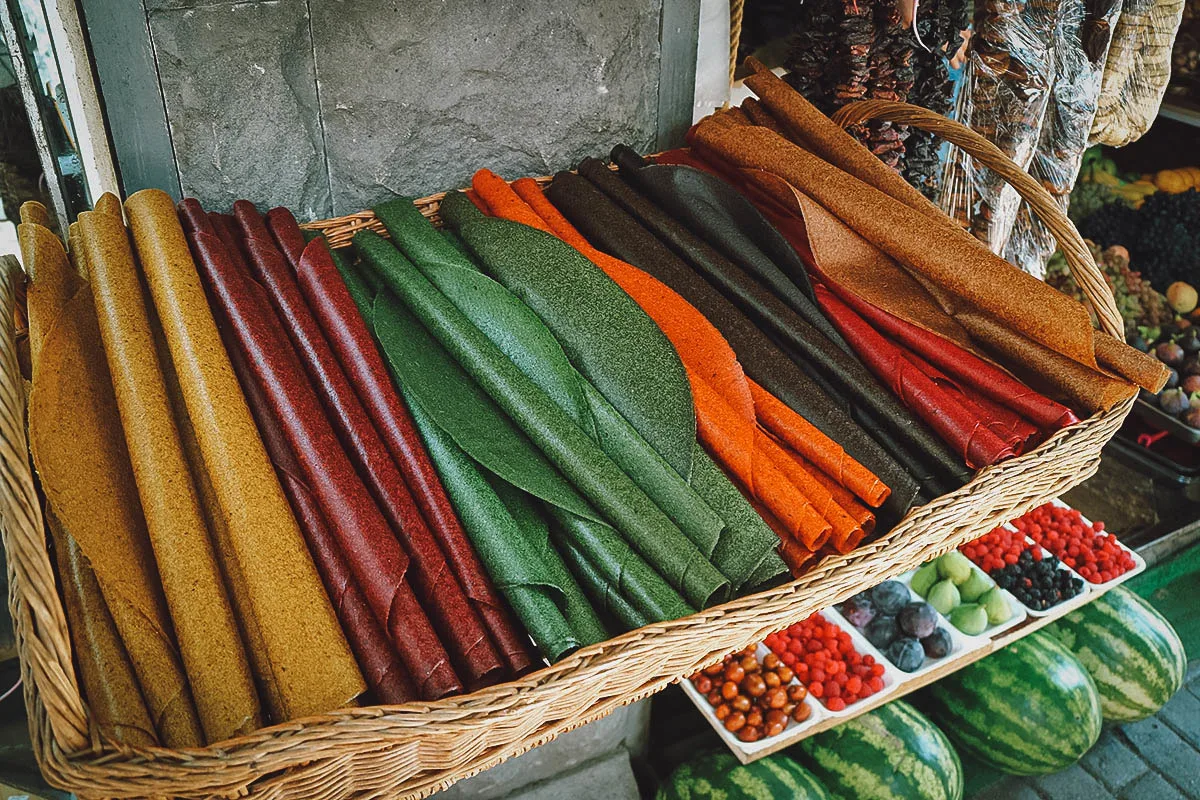
Photo by shinylion
29. Pomegranate
Along with apricots and grapes, pomegranates are among the most important fruits in Armenian culture. It’s an indigenous fruit of the Armenian Highlands and regarded as a symbol of the country, one that represents fertility, abundance, and marriage.
Pomegranates are a staple fruit in every Armenian household. Tart and mildly sweet, they’re typically eaten fresh with their seeds often used as a garnish in various meat and fish dishes. Pomegranate juice is a popular beverage which can also be fermented to produce a semi-sweet pomegranate wine with many health benefits.
RECIPE: Pomegranate martini
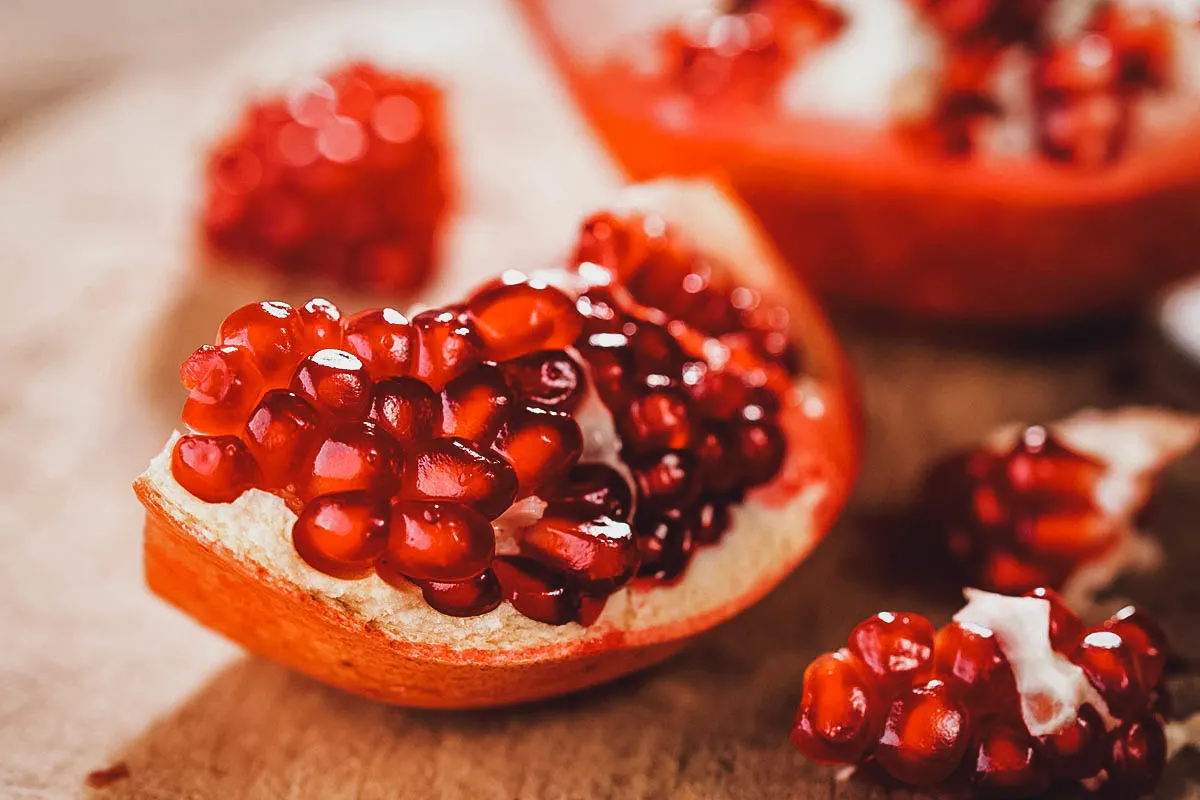
Photo by fotovincek
30. Dried Fruit
Visit any Armenian market and you’re sure to find dozens of varieties of dried fruit. Like pomegranates, they aren’t an Armenian dish per se but they’ve been an important part of the Armenian culinary tradition for thousands of years. Dried fruits like apricots, black plums, sour cherries, and sumac berries are often used as main ingredients or souring agents in Armenian soups, pudding, cakes, and dolma.
RECIPE: Gata with dried fruit and nuts
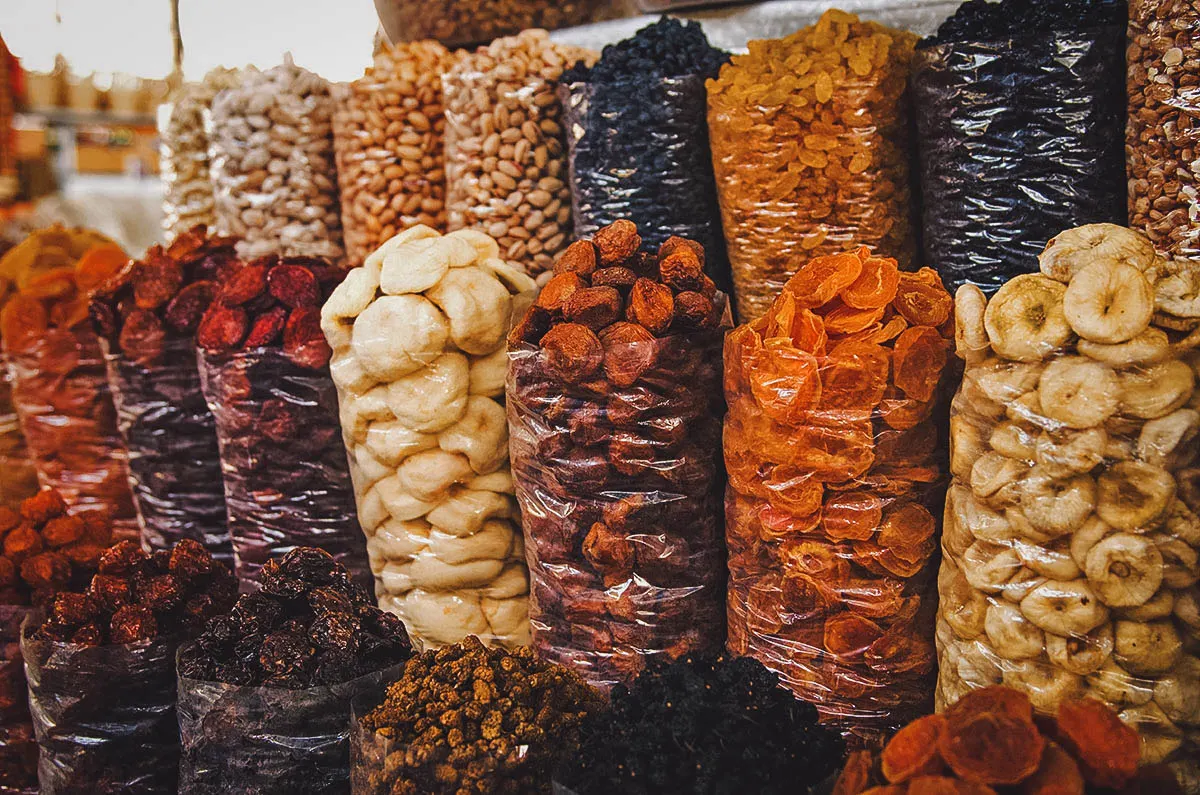
Photo by Marianarbh1
ARMENIAN FOOD TOURS
As much fun as it is to traveleat on your own, there’s no denying that no one knows Armenian food better than a local. You can do all the research you want but one of the best and easiest ways to experience Armenian cuisine is to go on a food tour.
Not only will a local take you to the city’s best markets and restaurants, but they’ll be able to explain all the Armenian dishes to you in more detail. Check out Get Your Guide for a list of Armenian food and wine tours in Yerevan and other cities throughout the country.
FINAL THOUGHTS ON ARMENIAN FOOD
Armenian food is complicated but fascinating. It tells a story many centuries old of kingdoms, conquerors, migration, and assimilation. As an outsider, I can never hope to fully understand it but it’s certainly opened my eyes to this part of the world and its ever-evolving cuisine.
As one Yerevan-born Armenian puts it, “I don’t think culture is static. Culture always changes. Food is one of those things about culture that is the easiest to transform and change”. Armenian food is the perfect example of that.
Disclosure
Some of the links in this Armenian food guide are affiliate links, meaning we’ll get a small commission if you make a booking at no additional expense to you. We only recommend products and services that we use ourselves and firmly believe in. We really appreciate your support as it helps us make more of these free travel and food guides. Thank you so much!
Cover photo by shain55. Stock images via Depositphotos.


Arda Melanson
Tuesday 5th of September 2023
Thoroughly enjoyed this segment on Armenian dishes. Well done!
JB & Renée
Saturday 9th of September 2023
Happy you enjoyed the article Arda!
Zohrab Bitar
Tuesday 2nd of May 2023
How can azerbtchjian be the owner of these dishes if they are only 100 years old? a 100 years ago you didnt have a background now u wanna tell people what comes first and what comes secnd
Arpi
Saturday 27th of August 2022
I’ve recently read that survivors from Musa Dagh who ended up in Syria invented and started to market lahmahjoon. That would explain the Arab-sounding name. I don’t know if this is true or not. I thought you might be able to check it out, should you wish to. Thanks.
JB & Renée
Thursday 1st of September 2022
Thank you for the insightful comments Arpi! Much appreciated.
Paula McCaul
Saturday 5th of February 2022
Absolutely wonderful article! Thanks so much for your presentation. Have enjoyed eating many of these dishes with some variety depending on culture, location, ect. Keep it coming, including recipes, if possible. Thanks again.
JB & Renée
Friday 11th of February 2022
Happy you enjoyed it Paula! Adding Armenian recipes is a great suggestion. We'll look into adding some on the next article update. Cheers!
Sina Davoudians
Wednesday 8th of September 2021
Hello and best regards. Please do more research on traditional Armenian cuisine. Because most of the foods introduced in this article as traditional Armenian food are in fact traditional foods of Azerbaijan (Urmia and Tabriz). To prove this, you can check the names of the foods written in this article in terms of lexical meaning and See if the name of these foods is Turkish or Armenian ?! You can also research the ingredients of those foods and see if they are native to which region or country. kind and hospitable Armenians have many traditional and old dishes that are not mentioned in this article. In my opinion, because of the proximity of the Armenian and Turkish residences of Azerbaijan, the expected customs are mixed. In my opinion, because Armenians are an ethnic immigrant and have been expelled from their native lands by governments like the Ottomans and even before the Ottomans in the past, to understand their traditional culture one has to go to those areas.
misha
Wednesday 14th of December 2022
@Sina Davoudians, ever heard of the kingdom of armenia? azerbaijan was in it and parts of turkey so thats why armenian food is sometimes from other parts of middle east, they used to be way bigger haveing land in most alot of northern middle east countrys such as geogia, azerbaijan, parts of turkey, syria, iran, and others like that.
Arpi
Saturday 27th of August 2022
@JB & Renée, Sina, like many Armenians, are way to willing to attribute to others what is indeed Armenia’s. They do not even know that agriculture and viticulture originated in the Armenian Highland (no s). Nor do they know that many animals were first domesticated in the Armenian Highlands. In other words many of the foods described probably existed centuries, if not millennia, before the turks left Mongolia and came to pillage Armenia. The names of foods might have been change, but that does not mean they were not originally Armenian.
Varduhi Sukiasyan
Sunday 19th of September 2021
@JB & Renée, OH, here we go, an Unknown Azerbaijani troll attacker. Thanks for your post, but it's useless to explain something to these subjects. They have a duty, to track through internet word Armenia and to attack with misleading, lies about my country. Well Azerbaijan is younger than Coca-Cola. That's it
JB & Renée
Thursday 9th of September 2021
Hi Sina, thanks for your insightful comment. I understand your point about lines being blurred but I think you may be confusing native with traditional. Traditional just means "long-standing" so the more important question here is, how long does a dish need to exist in any region for it to qualify as "traditional"?
Satay is Indonesian but it's now considered a national dish of Malaysia as well. Are Malaysians not allowed to refer to it as traditional? The empanada is Spanish in origin but it's become an important part of the cuisines of many countries in Latin America and the Philippines. Are Venezuelans, Argentinians, Chileans, Filipinos, etc not allowed to call it a traditional dish?
To go back even further, the empanada like the Indian samosa is said to be derived from the sambosa which dates back to the 10th century Middle East. By that definition, are Indians not allowed to refer to the samosa as a traditional dish? Same with the Spaniards and the empanada. Seems like such a narrow and overly rigid way of thinking.
You also talk about ingredients. Cattle didn't exist in Argentina until the Spanish settlers introduced them in the mid-16th century. Does that mean that you can't call the asado an Argentinian tradition? I think 45 million Argentinians would vehemently disagree with you.
And it's pretty clear how important the chili pepper is to traditional Thai cuisine, an ingredient that didn't exist in Thailand until it was brought by Portuguese merchants. Does that mean then that all Thai recipes that make use of chili aren't traditional? That seems absurd.
In any case, I'll be in Armenia for a month in March, restrictions willing. I look forward to learning more about the local food and culture. All the best.